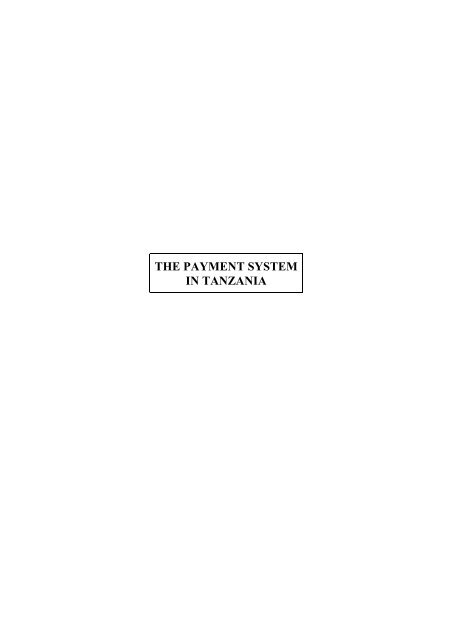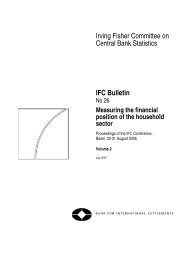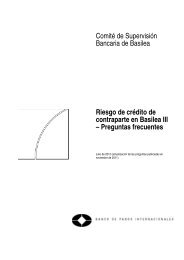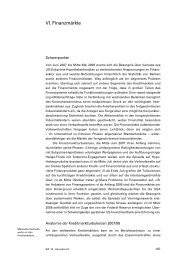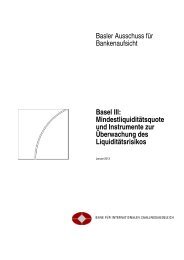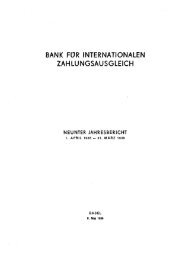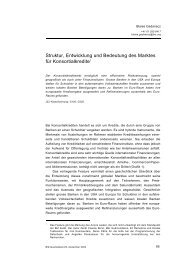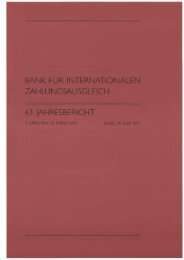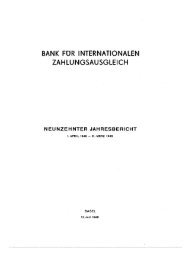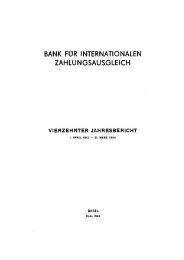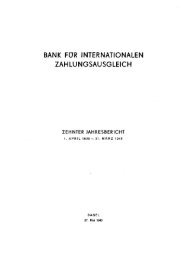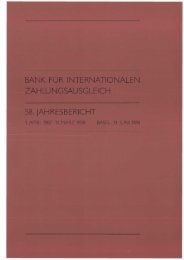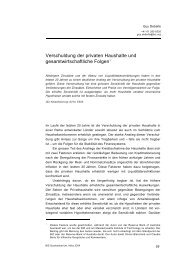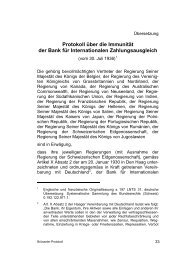Payment systems in Tanzania - Bank for International Settlements
Payment systems in Tanzania - Bank for International Settlements
Payment systems in Tanzania - Bank for International Settlements
You also want an ePaper? Increase the reach of your titles
YUMPU automatically turns print PDFs into web optimized ePapers that Google loves.
THE PAYMENT SYSTEM<br />
IN TANZANIA
Table of Contents<br />
OVERVIEW OF THE NATIONAL PAYMENT SYSTEM IN TANZANIA ............................ 193<br />
1. INSTITUTIONAL ASPECTS .............................................................................................. 194<br />
1.1 General legal aspects ..................................................................................................... 194<br />
1.2 Role of f<strong>in</strong>ancial <strong>in</strong>termediaries that provide payment services .............................. 196<br />
1.2.1 Commercial banks .............................................................................................. 196<br />
1.2.2 Non-bank f<strong>in</strong>ancial <strong>in</strong>stitutions .......................................................................... 196<br />
1.2.3 Other <strong>in</strong>stitutions that provide payment services ............................................... 197<br />
1.3 The role of the central bank ......................................................................................... 197<br />
1.3.1 Currency issuance .............................................................................................. 198<br />
1.3.2 <strong>Payment</strong> services ................................................................................................ 198<br />
1.3.3 Advice to the Governments ................................................................................. 198<br />
1.3.4 Supervision of banks and f<strong>in</strong>ancial <strong>in</strong>stitutions .................................................. 198<br />
1.3.5 Promotion of f<strong>in</strong>ancial development ................................................................... 198<br />
1.4 The role of other private and public sector bodies <strong>in</strong> payment <strong>systems</strong> .................. 199<br />
1.4.1 <strong>Bank</strong>ers clear<strong>in</strong>g houses ..................................................................................... 199<br />
1.4.2 <strong>Tanzania</strong> Institute of <strong>Bank</strong>ers (TIOB) ................................................................ 199<br />
1.4.3 <strong>Tanzania</strong> <strong>Bank</strong>ers Association (TBA) ................................................................. 199<br />
1.4.4 The Advisory Council of the National <strong>Payment</strong> Systems (NPS) ......................... 199<br />
1.4.5 The National Board of Accountants and Auditors (NBAA) ................................ 199<br />
2. SUMMARY INFORMATION ON PAYMENT MEDIA USED BY NON-BANKS ....... 199<br />
2.1 Cash payments ............................................................................................................... 199<br />
2.2 Non-cash payments ....................................................................................................... 200<br />
2.2.1 Credit transfers ................................................................................................... 200<br />
2.2.2 Cheques ............................................................................................................... 200<br />
2.2.3 Direct debits ....................................................................................................... 201<br />
2.2.4 <strong>Payment</strong> cards .................................................................................................... 201<br />
2.2.5 Other payment <strong>in</strong>struments ................................................................................. 201<br />
3. PRESENT INTERBANK EXCHANGE AND SETTLEMENT ....................................... 202<br />
3.1 General overview .......................................................................................................... 202<br />
3.2 Structure, operation and adm<strong>in</strong>istration .................................................................... 202<br />
3.2.1 Major legislation, regulation and policies ......................................................... 202<br />
3.2.2 Participants <strong>in</strong> the clear<strong>in</strong>g and settlement system ............................................ 203<br />
3.2.3 Types of transactions handled ............................................................................ 203<br />
3.2.4 Operation of the transfer <strong>systems</strong> ....................................................................... 203<br />
3.2.5 Transaction-process<strong>in</strong>g environment ................................................................. 204<br />
3.2.6 Settlement process .............................................................................................. 204<br />
3.2.7 Pric<strong>in</strong>g policies ................................................................................................... 205<br />
3.2.8 Credit and liquidity risks .................................................................................... 205
4. SPECIAL USE OF INTERBANK TRANSFER SYSTEMS FOR INTERNATIONAL<br />
AND DOMESTIC FINANCIAL TRANSACTIONS ......................................................... 206<br />
4.1 Exchange and settlement <strong>systems</strong> <strong>for</strong> <strong>in</strong>ternational transactions .......................... 206<br />
4.1.1 General overview ................................................................................................ 206<br />
4.1.2 Retail transactions .............................................................................................. 206<br />
4.1.3 Foreign currencies trad<strong>in</strong>g ................................................................................. 207<br />
4.2 Exchange and settlement <strong>systems</strong> <strong>for</strong> securities transactions ................................. 207<br />
5. THE ROLE OF THE CENTRAL BANK IN INTERBANK SETTLEMENT<br />
SYSTEMS .............................................................................................................................. 208<br />
5.1 General responsibilities .............................................................................................. 208<br />
5.1.1 Statutory responsibilities .................................................................................... 208<br />
5.1.2 Establishment of common rules .......................................................................... 208<br />
5.2 Provision of settlement and credit facilities ............................................................. 209<br />
5.2.1 The provision and ownership of settlement facilities ......................................... 209<br />
5.2.2 Role <strong>in</strong> <strong>in</strong>terbank settlement ............................................................................... 209<br />
5.2.3 Roles <strong>in</strong> the settlement of securities transactions ............................................... 209<br />
5.3 Monetary policy and payment <strong>systems</strong> ..................................................................... 209<br />
5.3.1 Objectives of monetary policy implementation .................................................. 209<br />
5.3.2 Instruments of monetary policy <strong>in</strong> <strong>Tanzania</strong> ...................................................... 210<br />
5.4 Risk-reduction measures ............................................................................................ 211<br />
5.4.1 Credit and liquidity risks .................................................................................... 211<br />
5.4.2 Cross-currency settlement risks ......................................................................... 211<br />
5.4.3 Operational risks ................................................................................................ 211<br />
6. RECENT DEVELOPMENTS IN THE PAYMENT SYSTEMS ...................................... 212<br />
6.1 The National <strong>Payment</strong> Systems Modernisation Project .......................................... 212<br />
6.2 Other developments .................................................................................................... 213<br />
7. INFRASTRUCTURE ............................................................................................................ 213<br />
7.1 Telecommunications <strong>in</strong>frastructure .......................................................................... 213<br />
7.2 Availability of electricity ............................................................................................ 215<br />
7.3 Road <strong>in</strong>frastructure .................................................................................................... 215<br />
7.4 Economic re<strong>for</strong>ms ....................................................................................................... 215<br />
Tables ................................................................................................................................................ 217<br />
References ........................................................................................................................................ 220
- 193 - <strong>Tanzania</strong><br />
OVERVIEW OF THE NATIONAL PAYMENT SYSTEM IN TANZANIA<br />
<strong>Tanzania</strong> had a socialist-centrally-planned economy <strong>for</strong> about 30 years after<br />
<strong>in</strong>dependence with one state owned bank dom<strong>in</strong>at<strong>in</strong>g the bank<strong>in</strong>g <strong>in</strong>dustry <strong>for</strong> about 25 years until<br />
1993 when the f<strong>in</strong>ancial <strong>in</strong>dustry was liberalised.<br />
Cash has been the dom<strong>in</strong>ant payment <strong>in</strong>strument with little usage of cheques and<br />
telegraphic transfers as ma<strong>in</strong> debit and credit <strong>in</strong>struments respectively. There were no clear<strong>in</strong>g houses<br />
until 1993 when one was <strong>in</strong>troduced <strong>in</strong> Dar Es Salaam. Be<strong>for</strong>e then, clear<strong>in</strong>g of paper-based<br />
<strong>in</strong>struments was purely on bilateral arrangements.<br />
There had been no “free” f<strong>in</strong>ancial markets1 until 1993 when Treasury Bills started to be<br />
traded <strong>in</strong> a primary “free” market us<strong>in</strong>g the physical script. This is expla<strong>in</strong>ed <strong>in</strong> detail <strong>in</strong> Section<br />
4.2 (a).<br />
There has been no comprehensive unified law govern<strong>in</strong>g payment, clearance and<br />
settlement <strong>systems</strong>.<br />
As the exist<strong>in</strong>g payment <strong>systems</strong> are ma<strong>in</strong>ly cash based, most transactions and payments<br />
are effected outside the bank<strong>in</strong>g system. This has resulted <strong>in</strong> a trebl<strong>in</strong>g of currency <strong>in</strong> circulation over<br />
the last five years thus <strong>in</strong>creas<strong>in</strong>g transaction costs due to immobility and costs of pr<strong>in</strong>t<strong>in</strong>g and<br />
distribution. Currency distribution is done through central bank branches and custody centres with<strong>in</strong><br />
commercial bank branches.<br />
F<strong>in</strong>ancial deepen<strong>in</strong>g2 has stood at about 30% over the last five years with cash believed<br />
to account <strong>for</strong> roughly about 40% of the total bank payments followed by cheques estimated to<br />
account <strong>for</strong> about 80% of all commercial bank paper based payments <strong>in</strong> the country. 3<br />
<strong>Bank</strong><strong>in</strong>g coverage of population per branch is poor with a total of 14 banks <strong>in</strong> existence.<br />
Most banks are relatively new with limited coverage. The largest bank controls about 60% of the<br />
country’s deposit money and handles approximately 80% of the total volume of cheques. Daily<br />
<strong>in</strong>tra-bank cheque volume is estimated to be 50,000 items. It is the only bank with a nationwide<br />
coverage hav<strong>in</strong>g over 130 branches up to district level. The second largest bank has 20 branches, all at<br />
a regional level, while other banks only have one to three branches, mostly concentrated <strong>in</strong> Dar Es<br />
Salaam.<br />
Interbank clear<strong>in</strong>g is manual with nett<strong>in</strong>g at end of day <strong>for</strong> settlement via clear<strong>in</strong>g<br />
accounts held at the <strong>Bank</strong> of <strong>Tanzania</strong> (BOT). Comprehensive clear<strong>in</strong>g rules exist. Interbank clear<strong>in</strong>g<br />
<strong>in</strong> the cities with<strong>in</strong> clear<strong>in</strong>g houses latitudes is done <strong>in</strong> 3 days and a maximum of 28 days <strong>for</strong> remote<br />
clear<strong>in</strong>g. The actual effect on customer accounts varies from 5 to 30 days or more depend<strong>in</strong>g on bank<br />
procedures.<br />
Some banks use S.W.I.F.T. ma<strong>in</strong>ly <strong>for</strong> <strong>in</strong>ternational funds transfer. While S.W.I.F.T.<br />
transfers can take up to 3 days be<strong>for</strong>e the beneficiary’s account is credited other means such as<br />
telegraphic transfers can take weeks be<strong>for</strong>e the <strong>Tanzania</strong>n shill<strong>in</strong>g cover is provided, even after<br />
payment has been cleared.<br />
<strong>Tanzania</strong> launched a payment <strong>systems</strong> modernisation project <strong>in</strong> August 1996. Its primary<br />
objective is to modernise the country’s payment, clear<strong>in</strong>g and settlement <strong>systems</strong> <strong>in</strong> order to atta<strong>in</strong><br />
<strong>in</strong>ternationally acceptable best practices by decreas<strong>in</strong>g risks and <strong>in</strong>creas<strong>in</strong>g convenience, af<strong>for</strong>dability<br />
and timel<strong>in</strong>ess of the <strong>systems</strong>. The other objectives are: to improve macro economic management<br />
1 In the sense that be<strong>for</strong>e then, deal<strong>in</strong>gs <strong>in</strong> the money market were based on Government determ<strong>in</strong>ed rates.<br />
2 Def<strong>in</strong>ed as M2/GDP.<br />
3 Nonetheless, it is possible that payment statistics are substantially under-recorded s<strong>in</strong>ce many transactions are conducted<br />
<strong>in</strong> the <strong>in</strong><strong>for</strong>mal sector.
- 194 - <strong>Tanzania</strong><br />
capabilities; speed up exchange and settlement of funds and securities; and to migrate, <strong>in</strong> the long<br />
term, from cash to cash-less modes of payment.<br />
Also along with this project are improvements which are currently <strong>in</strong> the implementation<br />
stage. These are: document process<strong>in</strong>g us<strong>in</strong>g MICR technology; <strong>in</strong>terbank communication network<br />
us<strong>in</strong>g the <strong>Bank</strong> of <strong>Tanzania</strong> backbone; media exchange process<strong>in</strong>g us<strong>in</strong>g diskettes <strong>for</strong> bulk recurr<strong>in</strong>g<br />
payments; and transmission of domestic secured payment <strong>in</strong>structions us<strong>in</strong>g S.W.I.F.T. architecture.<br />
There are factors that have contributed favourably to the process of modernisation which<br />
<strong>in</strong>clude: the country has been undergo<strong>in</strong>g major political and economic re<strong>for</strong>ms over the past decade;<br />
the f<strong>in</strong>ancial sector and markets are be<strong>in</strong>g liberalised <strong>for</strong> both private and <strong>for</strong>eign <strong>in</strong>vestments; the fact<br />
that the current legal framework is rather fragmented and outdated, fraught with <strong>in</strong>adequacies and<br />
<strong>in</strong>capable of regulat<strong>in</strong>g the National <strong>Payment</strong> Systems; the public need <strong>for</strong> efficient payment <strong>systems</strong><br />
to serve a new market economy; and the <strong>Bank</strong> of <strong>Tanzania</strong> management commitment to the project<br />
and a dedicated project team work<strong>in</strong>g on full time basis and <strong>in</strong> coord<strong>in</strong>ation with other Southern<br />
Africa Development Community (SADC) countries.<br />
1. INSTITUTIONAL ASPECTS<br />
1.1 General legal aspects<br />
There is no general legislation govern<strong>in</strong>g the payment <strong>systems</strong> <strong>in</strong> <strong>Tanzania</strong>, though the<br />
<strong>Bank</strong> of <strong>Tanzania</strong> ma<strong>in</strong>ta<strong>in</strong>s a close <strong>in</strong>volvement <strong>in</strong> supervision and regulation. English/common law<br />
is the orig<strong>in</strong> of the law <strong>in</strong> <strong>Tanzania</strong>, while the follow<strong>in</strong>g is the key legislation, which directly touches<br />
on payment <strong>systems</strong>.<br />
(a) The Bills of Exchange Ord<strong>in</strong>ance, Cap. 215<br />
The Bills of Exchange Ord<strong>in</strong>ance, Cap. 215 is a statute <strong>in</strong> pari materia with the Bills of<br />
Exchange Act, 1882 of the United K<strong>in</strong>gdom.<br />
(b) The Evidence Act, 1967<br />
The <strong>Tanzania</strong>n evidence law has its orig<strong>in</strong> <strong>in</strong> India and the United K<strong>in</strong>gdom. Part IV of<br />
the Evidence Act, 1967 provides <strong>for</strong> <strong>Bank</strong>ers Books Evidence.<br />
(c) The <strong>Bank</strong><strong>in</strong>g and F<strong>in</strong>ancial Institutions Act, 1991<br />
The <strong>Bank</strong><strong>in</strong>g and F<strong>in</strong>ancial Institutions Act, 1991 (BAFI) was enacted to consolidate the<br />
law relat<strong>in</strong>g to the bus<strong>in</strong>ess of bank<strong>in</strong>g, to harmonise the operations of all f<strong>in</strong>ancial <strong>in</strong>stitutions <strong>in</strong><br />
<strong>Tanzania</strong>.<br />
(d) The <strong>Bank</strong> of <strong>Tanzania</strong> Act, 1995<br />
The purpose of this Act was to repeal and re-enact the <strong>Bank</strong> of <strong>Tanzania</strong> Act, 1965 so as<br />
to provide more def<strong>in</strong>itively the regulatory and supervisory powers of the <strong>Bank</strong> of <strong>Tanzania</strong> over<br />
other banks and f<strong>in</strong>ancial <strong>in</strong>stitutions. (For a fuller description of this, see Section 1.3.)<br />
(e) The Cheques Act, 1969<br />
The Bills of Exchange Ord<strong>in</strong>ance, Cap. 215, largely governs the use of cheques. The<br />
Cheques Act provides <strong>for</strong> the protection of bankers <strong>in</strong> relation to transactions concluded through<br />
payment by use of cheques and other related <strong>in</strong>struments.
- 195 - <strong>Tanzania</strong><br />
(f) The <strong>Bank</strong>ruptcy Ord<strong>in</strong>ance, Cap. 25<br />
The Ord<strong>in</strong>ance regulates <strong>in</strong>dividuals’ and partnerships’ <strong>in</strong>solvency proceed<strong>in</strong>gs.<br />
However, the ord<strong>in</strong>ance is <strong>in</strong>applicable to body corporates like banks.<br />
(g) The Capital Market and Securities Act, 1994<br />
The Capital Market and Securities Act, 1994 was enacted to promote and facilitate the<br />
development of an orderly, fair, efficient capital and securities market <strong>in</strong> <strong>Tanzania</strong>.<br />
(h) The Fair Trade Practices Act, 1994<br />
The Act encourages competition <strong>in</strong> the economy. It prohibits restrictive trade practices,<br />
regulates monopolies and their concentration of economic power and prices. The Act is also <strong>in</strong>tended<br />
to protect the consumer aga<strong>in</strong>st alltrade malpractice and also provides <strong>for</strong> other related matters.<br />
(i) The Government Loans, Guarantees and Grants<br />
The Act was enacted to revise and consolidate the written laws relat<strong>in</strong>g to loans raised<br />
and guarantees given by the government and to provide <strong>for</strong> the acceptance of grants made to the<br />
government and <strong>for</strong> matters connected therewith and <strong>in</strong>cidental thereto.<br />
(j) The Arbitration Ord<strong>in</strong>ance Cap. 15<br />
The ord<strong>in</strong>ance governs arbitral proceed<strong>in</strong>gs referred to the Arbitrators but otherwise<br />
triable by the High Court.<br />
(k) The Contract Ord<strong>in</strong>ance, Cap.433<br />
The Ord<strong>in</strong>ance provides <strong>for</strong> most of the pr<strong>in</strong>ciples of contract law.<br />
(l) The Companies Ord<strong>in</strong>ance, Cap. 212<br />
The Ord<strong>in</strong>ance regulates activities and affairs of all companies <strong>in</strong>corporated and or<br />
registered to do bus<strong>in</strong>ess <strong>in</strong> <strong>Tanzania</strong>. It further provides <strong>for</strong> the w<strong>in</strong>d<strong>in</strong>g up procedures of companies<br />
<strong>in</strong>corporated under it.<br />
(m) The Civil Procedure Code, 1966<br />
The Civil Procedure Code is a procedural law which proscribes procedures <strong>for</strong> disposal<br />
of civil suits <strong>in</strong>stituted <strong>in</strong> the High Courts and courts subord<strong>in</strong>ate thereto (Resident Magistrates and<br />
District Courts). It provides <strong>for</strong> procedures through which the court can restore a right to an aggrieved<br />
citizen.<br />
(n) The Penal Code, Cap.16<br />
The Penal Code codifies crim<strong>in</strong>al offences and provides <strong>for</strong> punishments thereof. The<br />
code makes it an offence <strong>for</strong> a person to obta<strong>in</strong> money or credit by cheque without hav<strong>in</strong>g sufficient<br />
funds.<br />
(o) Transfer of Bus<strong>in</strong>ess (Protection of Creditors) Ord<strong>in</strong>ance, Cap. 398<br />
This ord<strong>in</strong>ance is <strong>in</strong>tended to protect creditors and even <strong>in</strong> the event that a debtor, who is<br />
a body corporate, <strong>in</strong>tends to transfer either wholly or substantial part of its bus<strong>in</strong>ess to another<br />
person/or body corporate.
- 196 - <strong>Tanzania</strong><br />
1.2 Role of f<strong>in</strong>ancial <strong>in</strong>termediaries that provide payment services<br />
Two broad categories of f<strong>in</strong>ancial <strong>in</strong>termediaries <strong>in</strong> the bank<strong>in</strong>g system exist, namely:<br />
commercial banks and non-bank f<strong>in</strong>ancial <strong>in</strong>stitutions. Their number, as of August 1997, subdivided<br />
<strong>in</strong>to local and <strong>for</strong>eign <strong>in</strong>stitutions, are given <strong>in</strong> the follow<strong>in</strong>g table:<br />
Institutions Total number Local owned Foreign owned<br />
Commercial banks................................................... 14 6 8<br />
Non-bank f<strong>in</strong>ancial <strong>in</strong>stitutions ............................... 13 11 2<br />
1.2.1 Commercial banks<br />
These are deposit money banks that <strong>in</strong>cur liabilities <strong>in</strong> the <strong>for</strong>m of deposits payable on<br />
demand and transferable by cheque or otherwise <strong>in</strong> mak<strong>in</strong>g payments. They lend and provide other<br />
bank<strong>in</strong>g services, <strong>in</strong>clud<strong>in</strong>g payment services, to the public. The 14 licensed commercial banks have<br />
approximately 170 branches.<br />
For the year ended June 1996, commercial banks’ credit to all sectors of the economy<br />
decl<strong>in</strong>ed by <strong>Tanzania</strong> Shill<strong>in</strong>g (TZS) 136.1 billion, or 50.2%, when compared with the previous year.<br />
On the other hand, with<strong>in</strong> the same period deposits, exclud<strong>in</strong>g house accounts liabilities and<br />
Government deposits, <strong>in</strong>creased by TZS 72.1 billion or 13.7%. Foreign currency deposits cont<strong>in</strong>ue to<br />
dom<strong>in</strong>ate the <strong>in</strong>crease <strong>in</strong> commercial banks deposits, account<strong>in</strong>g <strong>for</strong> 39.3% of the recorded growth <strong>in</strong><br />
deposits. Time deposits accounted <strong>for</strong> a mere 10.8%, while Sav<strong>in</strong>gs and Demand Deposits,<br />
contributed 31.2% and 18.7% respectively.<br />
Membership of the Clear<strong>in</strong>g House is restricted to commercial banks while other<br />
non-bank f<strong>in</strong>ancial <strong>in</strong>stitutions which are also deposit tak<strong>in</strong>g <strong>in</strong>stitutions participate <strong>in</strong> the clear<strong>in</strong>gs<br />
via agency agreements with member banks.<br />
1.2.2 Non-bank f<strong>in</strong>ancial <strong>in</strong>stitutions<br />
These are grouped <strong>in</strong>to deposit and non-deposit tak<strong>in</strong>g f<strong>in</strong>ancial <strong>in</strong>stitutions.<br />
(a) Deposit tak<strong>in</strong>g <strong>in</strong>stitutions<br />
They are deposit tak<strong>in</strong>g but <strong>in</strong>cur liabilities <strong>in</strong> <strong>for</strong>ms other than demand deposits, say time<br />
and sav<strong>in</strong>gs deposits Also they mobilise deposits, offer<strong>in</strong>g various types of deposit schemes (<strong>in</strong><br />
<strong>Tanzania</strong>n Shill<strong>in</strong>g and <strong>for</strong>eign exchange); provid<strong>in</strong>g bank<strong>in</strong>g services (other than cheque accounts)<br />
and participate <strong>in</strong> money market operations. For example, <strong>Tanzania</strong> Postal <strong>Bank</strong>, which is popular <strong>for</strong><br />
small value savers, uses <strong>Tanzania</strong> Posts Corporation offices on agency agreement to service remote<br />
parts (<strong>in</strong>clud<strong>in</strong>g rural areas) of the country.<br />
(b) Non-deposit tak<strong>in</strong>g <strong>in</strong>stitutions<br />
These can be grouped as follows:<br />
– <strong>in</strong>stitutions offer<strong>in</strong>g leas<strong>in</strong>g and hire purchase services - this service had been<br />
monopolised by one state-owned company until the <strong>Bank</strong><strong>in</strong>g and F<strong>in</strong>ancial Institutions<br />
Act of 1991 was enacted, then other companies started to compete;<br />
– <strong>in</strong>stitutions offer<strong>in</strong>g development f<strong>in</strong>ance - these provide long-term f<strong>in</strong>ance to the public<br />
and private sector <strong>in</strong> the <strong>for</strong>m of loans <strong>for</strong> medium to large-scale <strong>in</strong>vestment. Due to stiff
- 197 - <strong>Tanzania</strong><br />
competition from commercial banks these <strong>in</strong>stitutions are plann<strong>in</strong>g to become merchant<br />
banks;<br />
– <strong>in</strong>stitutions offer<strong>in</strong>g pension funds and <strong>in</strong>surance services - the most active of all groups<br />
<strong>in</strong> terms of outreach, volume and frequency of payments. They <strong>in</strong>clude:<br />
(i) Pension funds<br />
National Provident Fund (NPF) - with branches <strong>in</strong> all regions act<strong>in</strong>g as collect<strong>in</strong>g centres<br />
<strong>for</strong> statutory pension collections from all salaried non-parastatal employees. Parastatal Pension Fund<br />
(PPF) has neither branches nor any operations outside its Dar Es Salaam head office. It caters <strong>for</strong><br />
parastatal employees only.<br />
(ii) Insurance companies<br />
One <strong>in</strong>surance company, the National Insurance Corporation (NIC), has the sole<br />
monopoly with collection and payment centres throughout the country. A bill has, however, been<br />
passed to allow <strong>in</strong>troduction of private <strong>in</strong>surance and a review of the pension structure is <strong>in</strong> the<br />
pipel<strong>in</strong>e.<br />
1.2.3 Other <strong>in</strong>stitutions that provide payment services<br />
They are grouped <strong>in</strong>to four major categories.<br />
(a) Bureau de change <strong>in</strong>stitutions<br />
They provide a retail <strong>for</strong>eign exchange market. As non-bank currency shops, they are not<br />
allowed to participate <strong>in</strong> the Interbank Foreign Exchange Market.<br />
(b) Sundry <strong>in</strong>stitutions<br />
They offer auxiliary <strong>in</strong>termediation or support services to the national payment <strong>systems</strong>.<br />
For example, <strong>Tanzania</strong> Posts Corporation which, <strong>in</strong> addition to its traditional postal services, provides<br />
payment services through: postal mail transfers and local postal telegraphic transfers. <strong>Tanzania</strong> Posts<br />
Corporation has about 200 outlet offices throughout the country.<br />
(c) Sav<strong>in</strong>gs and Credit Co-operative Societies (SACCOS)<br />
These are primarily small member-owned societies of cooperative movements that are<br />
active <strong>in</strong> some parts of the country. About 450 SACCOS are <strong>in</strong> operation <strong>in</strong> <strong>Tanzania</strong>. They are<br />
potential <strong>in</strong>termediaries between the bank<strong>in</strong>g sector, the rural areas and micro-bus<strong>in</strong>esses.<br />
(d) Non-government organisations<br />
Primarily societies of cooperative movements that mobilise and allocate untapped<br />
f<strong>in</strong>ancial resources. Due to their limitation <strong>in</strong> scope and f<strong>in</strong>ance they target certa<strong>in</strong> groups of people<br />
fitt<strong>in</strong>g <strong>in</strong>to their scope of operation.<br />
1.3 The role of the central bank<br />
The <strong>Bank</strong> of <strong>Tanzania</strong> (BOT) Act, 1965 and its 1995 update spell out that the BOT is<br />
empowered as a central bank with the primary objective to <strong>for</strong>mulate and implement monetary policy,<br />
directed to the economic objective of ma<strong>in</strong>ta<strong>in</strong><strong>in</strong>g price stability over time. The <strong>Bank</strong> has also<br />
subsidiary functions that <strong>in</strong>clude currency issuance, bankers’ bank, Governments’ bank, the advisor to
- 198 - <strong>Tanzania</strong><br />
the Governments, 4 the guardian of the country’s <strong>in</strong>ternational reserves, supervision of banks and<br />
f<strong>in</strong>ancial <strong>in</strong>stitutions and promotion of f<strong>in</strong>ancial development.<br />
1.3.1 Currency issuance<br />
The <strong>Bank</strong> has the sole right to issue notes and co<strong>in</strong>s <strong>in</strong> <strong>Tanzania</strong>. The stocks of note and<br />
co<strong>in</strong>s are distributed through <strong>Bank</strong> of <strong>Tanzania</strong> headquarters, its 4 branches and 6 safe custody centres<br />
at various commercial bank branches which were established under agreements.<br />
1.3.2 <strong>Payment</strong> services<br />
The <strong>Bank</strong> provides central clearance and settlement facilities <strong>for</strong> <strong>in</strong>terbank transactions.<br />
The <strong>Bank</strong> of <strong>Tanzania</strong> accepts deposits to act as prudential reserves <strong>for</strong> commercial<br />
banks (i.e. the m<strong>in</strong>imum reserve); discounts commercial and government paper; and has the<br />
commitment to act as lender of last resort to these banks.<br />
The <strong>Bank</strong> is also the banker and the fiscal agent <strong>for</strong> the Governments. The <strong>Bank</strong> may<br />
make temporary advances to the Governments through its overdraft facility, subject to repayment<br />
with<strong>in</strong> 180 days and through purchases (direct or rediscount<strong>in</strong>g) of Treasury Bills issued by the<br />
Governments, which mature not less than 12 months from the date of issue.<br />
The <strong>Bank</strong> is the depository of the official external assets of <strong>Tanzania</strong>, <strong>in</strong>clud<strong>in</strong>g gold and<br />
<strong>for</strong>eign currency reserves. Guard<strong>in</strong>g <strong>in</strong>ternational reserves may imply the determ<strong>in</strong>ation of buy<strong>in</strong>g and<br />
sell<strong>in</strong>g rates of gold and <strong>for</strong>eign exchange <strong>in</strong> <strong>for</strong>eign exchange markets and/or the buy<strong>in</strong>g and sell<strong>in</strong>g<br />
of reserve assets <strong>for</strong> the purpose of susta<strong>in</strong><strong>in</strong>g the national currency’s external value.<br />
1.3.3 Advice to the Governments<br />
The <strong>Bank</strong> may advise the Governments on matters relat<strong>in</strong>g to its functions, powers,<br />
duties, the credit condition <strong>in</strong> <strong>Tanzania</strong> or propos<strong>in</strong>g measures and transactions relat<strong>in</strong>g thereto.<br />
1.3.4 Supervision of banks and f<strong>in</strong>ancial <strong>in</strong>stitutions<br />
The <strong>Bank</strong> <strong>in</strong>sures that commercial banks and other f<strong>in</strong>ancial <strong>in</strong>stitutions conduct their<br />
bus<strong>in</strong>ess on sound prudential basis and accord<strong>in</strong>g to the various laws and regulations <strong>in</strong> <strong>for</strong>ce. It<br />
<strong>in</strong>cludes the supervision of bank<strong>in</strong>g conduct and the licens<strong>in</strong>g of f<strong>in</strong>ancial <strong>in</strong>stitutions <strong>in</strong> accordance<br />
with the Basle Committee recommendations.<br />
1.3.5 Promotion of f<strong>in</strong>ancial development<br />
The <strong>Bank</strong> has a responsibility to establish an effective f<strong>in</strong>ancial system. In this respect it<br />
has to facilitate advanced clear<strong>in</strong>g and transfer <strong>systems</strong> and the availability of necessary bank<strong>in</strong>g<br />
services, <strong>for</strong> example, deposit facilities and loan facilities, availability of certa<strong>in</strong> specialised<br />
<strong>in</strong>stitutions 5 and facilitation of a money market, a capital market and a <strong>for</strong>eign exchange market.<br />
4 The United Republic of <strong>Tanzania</strong> conta<strong>in</strong>s the Union and Zanzibar Governments.<br />
5 Which could be represented, <strong>for</strong> example, by an <strong>in</strong>dustrial development bank and/or an agricultural development bank<br />
and micro-f<strong>in</strong>ance <strong>in</strong>stitutions.
- 199 - <strong>Tanzania</strong><br />
1.4 The role of other private and public sector bodies <strong>in</strong> payment <strong>systems</strong><br />
Other entities that play a role <strong>in</strong> the <strong>Tanzania</strong> payments system <strong>in</strong>clude those that provide<br />
specialised clear<strong>in</strong>g services, sett<strong>in</strong>g National <strong>Payment</strong> Systems policies and account<strong>in</strong>g<br />
standard-sett<strong>in</strong>g or rule-writ<strong>in</strong>g functions.<br />
1.4.1 <strong>Bank</strong>ers clear<strong>in</strong>g houses<br />
Three <strong>Bank</strong>ers Clear<strong>in</strong>g Houses situated <strong>in</strong> three major cities were <strong>in</strong>troduced <strong>in</strong> 1993,<br />
1996 and 1997 respectively. Membership is limited to licensed commercial banks. Their ma<strong>in</strong> role is<br />
to facilitate the clearance of <strong>in</strong>terbank <strong>in</strong>struments, pr<strong>in</strong>cipally cheques.<br />
1.4.2 <strong>Tanzania</strong> Institute of <strong>Bank</strong>ers (TIOB)<br />
Its ma<strong>in</strong> role is to act as a regulatory and discipl<strong>in</strong>ary body <strong>for</strong> bank<strong>in</strong>g professionals and<br />
conduct all bankers professional research and exam<strong>in</strong>ations. Membership is restricted to corporate<br />
members (commercial banks and f<strong>in</strong>ancial <strong>in</strong>stitutions as <strong>in</strong>dicated <strong>in</strong> 1.2) and <strong>in</strong>dividual members<br />
from the corporate members.<br />
1.4.3 <strong>Tanzania</strong> <strong>Bank</strong>ers Association (TBA)<br />
TBA is an association of banks <strong>for</strong> safeguard<strong>in</strong>g matters of common <strong>in</strong>terest to members<br />
(all licensed deposit tak<strong>in</strong>g banks). It is the owner, manager and operator of the clear<strong>in</strong>g houses.<br />
1.4.4 The Advisory Council of the National <strong>Payment</strong> Systems (NPS)<br />
It is an apex body <strong>for</strong> decision-mak<strong>in</strong>g on issues perta<strong>in</strong><strong>in</strong>g to payment <strong>systems</strong>. Its<br />
members are heads of all NPS stakeholders. 6 The council has 4 work<strong>in</strong>g level committees deal<strong>in</strong>g<br />
with Standards, Operations, Legal-Regulatory and Automation issues perta<strong>in</strong><strong>in</strong>g to payment <strong>systems</strong>.<br />
1.4.5 The National Board of Accountants and Auditors (NBAA)<br />
An authority and regulatory body <strong>for</strong> account<strong>in</strong>g and audit<strong>in</strong>g standardisation.<br />
2. SUMMARY INFORMATION ON PAYMENT MEDIA USED BY NON-BANKS<br />
2.1 Cash payments<br />
The <strong>Bank</strong> of <strong>Tanzania</strong> currently issues notes <strong>in</strong> 7 denom<strong>in</strong>ations; TZS200, TZS500,<br />
TZS1,000, TZS5,000, TZS10,000, TZS20 and TZS10. As of June 1996, total notes <strong>in</strong> circulation was<br />
2.6%, 9.7%, 27.9%, 20.9%, 37.6%, 0.2% and 0.0% respectively <strong>in</strong> terms of percentages. Proportion of<br />
notes <strong>in</strong> relation to value of total currency <strong>in</strong> circulation was 98.2%.<br />
The <strong>Bank</strong> also issue co<strong>in</strong>s <strong>in</strong> 10 denom<strong>in</strong>ations: -/05, -/10, -/20, -/50, 1/-, 5/-, 10/-, 25/-,<br />
50/- and 100/-. As of June 1996, the percentage of total co<strong>in</strong>s <strong>in</strong> circulation was 0.2%, 0.1%, 0.9%,<br />
1.1%, 4.0%, 9.7%, 16.8%, 20.3%, 0.3% and 46.7% respectively. Proportion of co<strong>in</strong>s <strong>in</strong> relation to<br />
value of total cash <strong>in</strong> circulation was 1.8%.<br />
6 These are all heads of banks and non-bank f<strong>in</strong>ancial <strong>in</strong>stitutions.
- 200 - <strong>Tanzania</strong><br />
Dur<strong>in</strong>g the year ended June, 1996, the extended broad money (M3) 7 recorded a growth<br />
rate of 16.3%, while broad money (M2) 8 was 14.4% and narrow money (M1) 9 was 13.4%.<br />
The usage of cash relative to other payments over the past five years has dim<strong>in</strong>ished<br />
<strong>in</strong>significantly. There were no significant developments of other cash payment substitutes, e.g. plastic<br />
payments, dur<strong>in</strong>g the period.<br />
2.2 Non-cash payments<br />
2.2.1 Credit transfers<br />
<strong>Bank</strong>s effect transactions <strong>for</strong> credit transfer <strong>systems</strong> us<strong>in</strong>g telegraphic transfers (TT) and<br />
mail transfers (MT). Fund transfers through telegraphic transfers are relatively reliable and faster <strong>for</strong><br />
<strong>in</strong>trabank or <strong>in</strong>terbank transactions. Coded telex messages per<strong>for</strong>m the transfers. Transfers through<br />
mail transfer are popular <strong>for</strong> local <strong>in</strong>ter-branch payments and non-local payments where<br />
telecommunications is not available or is unreliable.<br />
Two options are available:<br />
– the orig<strong>in</strong>at<strong>in</strong>g bank branch communicates through its head office, which communicates<br />
with the head office of the receiv<strong>in</strong>g bank be<strong>for</strong>e the transfer is effected to the respective<br />
branches; or<br />
– the pay<strong>in</strong>g bank submits a banker’s payment cheque, draft or clearance transfer vouchers<br />
which may conta<strong>in</strong> funds <strong>for</strong> a number of payees with attached breakdown <strong>in</strong>structions to<br />
an agent bank head office.<br />
On receipt of the <strong>in</strong>strument, an agent bank transfers funds directly by a TT or MT to its<br />
branch at the dest<strong>in</strong>ation. The agent bank presents the item at the local clear<strong>in</strong>g house <strong>for</strong> settlement<br />
purposes.<br />
The ma<strong>in</strong> users of the credit transfer mechanism are corporate customers and banks with<br />
customers <strong>in</strong> places where the pay<strong>in</strong>g bank has no branch.<br />
2.2.2 Cheques<br />
The usage of cheques is <strong>in</strong>creas<strong>in</strong>g slowly. In 1994, the Dar Es Salaam Clear<strong>in</strong>g House<br />
(DBCH) 10 cleared about 415,000 items <strong>for</strong> a total value of about TZS 828bn. On a daily basis this<br />
works out to about 1800 - 2000 items <strong>for</strong> a value of TZS3.5 - 4.0bn. Currently, there are three clear<strong>in</strong>g<br />
houses estimated to clear between 2,000 - 2,500 items per day.<br />
Only commercial banks that ma<strong>in</strong>ta<strong>in</strong> current accounts with the central bank and the<br />
central bank are allowed to issue cheques.<br />
The low level of confidence <strong>in</strong> cheques, particularly <strong>in</strong> private transactions, is due to<br />
several reasons. Key amongst these are the problem of issu<strong>in</strong>g cheques without sufficient funds11 <strong>in</strong><br />
7 Extended Broad Money - def<strong>in</strong>ed as a sum of Broad Money (M2) and <strong>for</strong>eign currency deposits.<br />
8 Broad Money - def<strong>in</strong>ed as sum of Narrow Money (M1), time deposits and sav<strong>in</strong>gs deposits.<br />
9 Narrow Money - def<strong>in</strong>ed as sum of currency <strong>in</strong> circulation outside banks plus demand deposits.<br />
10 The first clear<strong>in</strong>g house to be <strong>in</strong>troduced <strong>in</strong> the country <strong>in</strong> 1993.<br />
11 Although the Penal Code, Cap. 16 of the laws of Tanazia declared this a crim<strong>in</strong>al offence, its en<strong>for</strong>cement has proven to<br />
be cumbersome.
- 201 - <strong>Tanzania</strong><br />
the account and delays <strong>in</strong> the clear<strong>in</strong>g system - it takes up to 28 days or more <strong>in</strong> remote parts of the<br />
country (it used to be months) - which <strong>in</strong>creases the chance of fraud and <strong>for</strong>gery.<br />
However, the paper cheque rema<strong>in</strong>s the most frequently used non-cash payment<br />
<strong>in</strong>strument <strong>in</strong> <strong>Tanzania</strong>. The majority of cheques are written by bus<strong>in</strong>esses <strong>for</strong> corporate, salary and<br />
pension payments. Generally, few <strong>in</strong>dividuals write cheques ma<strong>in</strong>ly because personal cheques are<br />
normally not accepted due to, among other reasons, the absence of unique identification.<br />
2.2.3 Direct debits<br />
Some banks provide direct debit services to their customers by use of “Stand<strong>in</strong>g/<strong>Bank</strong>ers<br />
orders”. This service is not common and is limited <strong>for</strong> <strong>in</strong>tra-bank transactions. However, some<br />
customers use it <strong>for</strong> recurr<strong>in</strong>g loan repayments, <strong>in</strong>surance premiums, water and electricity bills<br />
payments, house rents and hire purchase <strong>in</strong>stalments. The total number of direct debit transactions per<br />
any given time cannot be determ<strong>in</strong>ed with any reasonable degree of confidence.<br />
2.2.4 <strong>Payment</strong> cards<br />
Plastic cards are not issued <strong>for</strong> local payment use by the bank<strong>in</strong>g <strong>in</strong>dustry nor by<br />
non-bank f<strong>in</strong>ancial <strong>in</strong>stitutions. However, there are utility organisations issu<strong>in</strong>g prepaid cards <strong>for</strong><br />
bill-pay<strong>in</strong>g services <strong>in</strong>clud<strong>in</strong>g: payment of electricity bills (us<strong>in</strong>g a “pay as per your electricity<br />
consumption” pre-paid card) <strong>in</strong>troduced <strong>in</strong> 1996 by an electricity company and payment of phone bills<br />
by magnetic stripe cards <strong>in</strong>troduced by telecommunications companies.<br />
2.2.5 Other payment <strong>in</strong>struments<br />
There are a number of other payment <strong>in</strong>struments issued by some banks. These <strong>in</strong>clude:<br />
(a) <strong>Bank</strong>er’s payment cheque<br />
Usually drawn by banks on themselves to settle their obligations. Customers (even the<br />
Government) of the bank may apply <strong>for</strong> banker’s cheques <strong>in</strong> order to make payments under special<br />
arrangements. Customers pay commission <strong>for</strong> us<strong>in</strong>g the services of banker’s cheques.<br />
(b) Promissory notes<br />
The applicant signs a promissory note undertak<strong>in</strong>g to make the payment on due date.<br />
However, to effect payment, the signatory can issue a cheque, give a mandate <strong>for</strong> his account to be<br />
debited or even deliver cash to the bank to meet his obligation.<br />
(c) Travellers cheques<br />
One bank issues its own local travellers’ cheques <strong>in</strong> different denom<strong>in</strong>ations. It clears<br />
them like any other <strong>in</strong>tra-bank cheque. The traveller’s cheques are drawn on the bank’s head office<br />
with its branches act<strong>in</strong>g as sell<strong>in</strong>g agents that remit the proceeds to the head office. The travellers’<br />
cheques are sent to head office by courier when encashed by a branch. Other banks handle<br />
<strong>in</strong>ternational traveller’s cheques only.
- 202 - <strong>Tanzania</strong><br />
3. PRESENT INTERBANK EXCHANGE AND SETTLEMENT<br />
3.1 General overview<br />
Generally, all <strong>in</strong>terbank payments are first cleared between banks locally, usually through<br />
either bilateral agreements12 or a local clear<strong>in</strong>g house, be<strong>for</strong>e be<strong>in</strong>g cleared and settled between<br />
non-local branches of the same bank via <strong>in</strong>tra-bank clear<strong>in</strong>g mechanism.<br />
Practically, the <strong>in</strong>terbank clear<strong>in</strong>g can be grouped <strong>in</strong>to two separate major sub-<strong>systems</strong>:<br />
local clear<strong>in</strong>gs - with<strong>in</strong> clear<strong>in</strong>g house localities and non-local clearance - between up-country13 branches (where there is no clear<strong>in</strong>g house).<br />
Dar Es Salaam <strong>Bank</strong>ers Clear<strong>in</strong>g House (DBCH) was established <strong>in</strong> July 1993. It was the<br />
first clear<strong>in</strong>g house <strong>in</strong> the country, with the objective of, amongst others, mak<strong>in</strong>g arrangements <strong>for</strong> the<br />
speedy and economic collection of cheques, bills and other documents payable or deliverable at or<br />
through the offices of the members of the clear<strong>in</strong>g house. It has a comprehensive set of rules which<br />
adequately describe the procedures <strong>for</strong> clear<strong>in</strong>g cheques throughout the country <strong>in</strong> equitable terms.<br />
Later two more clear<strong>in</strong>g houses were established, <strong>in</strong> 1996 and 1997 respectively. All are bound by the<br />
same rules as <strong>for</strong> the DBCH. All clear<strong>in</strong>g processes <strong>in</strong> clear<strong>in</strong>g houses are manual.<br />
With<strong>in</strong> the city or town where a clear<strong>in</strong>g house is situated, the rules provide <strong>for</strong> an<br />
exchange of cheques each morn<strong>in</strong>g at the clear<strong>in</strong>g house. These facilities are located <strong>in</strong> the <strong>Bank</strong> of<br />
<strong>Tanzania</strong> premises. The rules allow 3 days clear<strong>in</strong>g <strong>in</strong> the cities and a maximum of 28 days <strong>for</strong> remote<br />
clear<strong>in</strong>g. Settlement is on multilateral net basis over banks’ current accounts at the <strong>Bank</strong> of <strong>Tanzania</strong><br />
at the end of day.<br />
There has been a general decl<strong>in</strong>e <strong>in</strong> use of DBCH <strong>in</strong> terms of average daily number of<br />
cheques be<strong>in</strong>g cleared. On the other hand, the total value of all cheques be<strong>in</strong>g cleared each day, on<br />
average, has been <strong>in</strong>creas<strong>in</strong>g modestly, as has the average value per cheque. The net settlement, on<br />
average, reduces by about 56% the total value be<strong>in</strong>g netted. In these cases the concentration of<br />
deposits of one bank is not as large as those controlled by the biggest bank <strong>in</strong> the country.<br />
3.2 Structure, operation and adm<strong>in</strong>istration<br />
3.2.1 Major legislation, regulation and policies<br />
There is no specific legislative framework govern<strong>in</strong>g the operations of the <strong>Tanzania</strong><br />
payment <strong>systems</strong> <strong>in</strong> general nor is there legislation <strong>for</strong> clear<strong>in</strong>g and/or <strong>in</strong>terbank settlement.<br />
The <strong>in</strong>struments mostly handled through the clear<strong>in</strong>g houses are cheques, drafts, mail<br />
transfers and other bills of exchange. They are subject to the provisions of the Bills of Exchange<br />
Ord<strong>in</strong>ance, 1882 and the <strong>Tanzania</strong> Cheques Act, 1969.<br />
The operations of all <strong>in</strong>terbank clear<strong>in</strong>gs are subject to regulations and rules set by<br />
members, through the <strong>Tanzania</strong> <strong>Bank</strong>ers Association and the <strong>Bank</strong> of <strong>Tanzania</strong>. Membership of the<br />
clear<strong>in</strong>g houses is open to any bank which, <strong>in</strong> the op<strong>in</strong>ion of the <strong>Bank</strong> of <strong>Tanzania</strong>, is eligible <strong>for</strong><br />
membership and agrees to the regulations and rules govern<strong>in</strong>g the operations of the clear<strong>in</strong>g house.<br />
The adm<strong>in</strong>istrative body of the clear<strong>in</strong>g houses is the Committee of Management<br />
consist<strong>in</strong>g of the Governor or Deputy Governor of the <strong>Bank</strong> of <strong>Tanzania</strong> (ex-officio chairman) and all<br />
the manag<strong>in</strong>g directors of commercial banks who are members of the clear<strong>in</strong>g houses.<br />
12 In regional towns where there is no clear<strong>in</strong>g house, banks have designated branches where they meet to exchange<br />
<strong>in</strong>struments bilaterally.<br />
13 Up-country <strong>for</strong> this purpose means remote parts of the country, i.e. away from clear<strong>in</strong>g house localities.
- 203 - <strong>Tanzania</strong><br />
Any new bank licensed thereafter becomes a member of the clear<strong>in</strong>g house by apply<strong>in</strong>g<br />
to the <strong>Bank</strong> of <strong>Tanzania</strong> us<strong>in</strong>g a special <strong>for</strong>m. The application <strong>for</strong> membership is discussed and<br />
decided at the next meet<strong>in</strong>g of the Committee of Management whose decision is f<strong>in</strong>al.<br />
3.2.2 Participants <strong>in</strong> the clear<strong>in</strong>g and settlement system<br />
Fourteen banks, <strong>in</strong>clud<strong>in</strong>g the <strong>Bank</strong> of <strong>Tanzania</strong>, are currently settlement members of the<br />
clear<strong>in</strong>g houses. They <strong>for</strong>ward the clear<strong>in</strong>g <strong>in</strong>struments to the clear<strong>in</strong>g house through their central<br />
account<strong>in</strong>g/clear<strong>in</strong>g departments. 14 The practice is that bank branches do not directly participate <strong>in</strong><br />
<strong>in</strong>terbank clear<strong>in</strong>g; they pass their <strong>in</strong>struments through their clear<strong>in</strong>g departments, which are situated<br />
<strong>in</strong> the head offices of each bank <strong>in</strong> Dar Es Salaam.<br />
All other non-bank f<strong>in</strong>ancial <strong>in</strong>stitutions participate <strong>in</strong> the clear<strong>in</strong>g arrangements through<br />
commercial banks.<br />
3.2.3 Types of transactions handled<br />
Only <strong>in</strong>terbank transactions as described <strong>in</strong> the rules and regulations <strong>for</strong> the clear<strong>in</strong>g<br />
houses are handled <strong>in</strong> the clear<strong>in</strong>g houses, these <strong>in</strong>clude: cheques, drafts, mail transfers, clearance<br />
transfer vouchers, direct debits and sight bills of exchange.<br />
<strong>Bank</strong>s ma<strong>in</strong>ta<strong>in</strong> at the <strong>Bank</strong> of <strong>Tanzania</strong> the follow<strong>in</strong>g accounts: Local Currency Current<br />
account (clear<strong>in</strong>g account), a United States Dollar (USD) account and Statutory M<strong>in</strong>imum Reserve<br />
(SMR) account. There are also separate accounts <strong>for</strong> government securities held by banks and on<br />
behalf of their customers.<br />
3.2.4 Operation of the transfer <strong>systems</strong><br />
(a) Local clear<strong>in</strong>gs<br />
With<strong>in</strong> a clear<strong>in</strong>g house area, rules provide <strong>for</strong> an exchange of cheques each morn<strong>in</strong>g<br />
between 10.00 a.m. and 10.30 a.m. at the clear<strong>in</strong>g house. Upon completion of the exchange, a<br />
multilateral net settlement position is manually calculated and the banks are notified of their net<br />
positions, usually by 11.00 a.m. Post<strong>in</strong>g the net positions to the current/clear<strong>in</strong>g account at the <strong>Bank</strong><br />
of <strong>Tanzania</strong> is at end of day. Rules also provide <strong>for</strong> special collection of items after clear<strong>in</strong>g through a<br />
bilateral arrangement. The maximum number of days <strong>for</strong> local clear<strong>in</strong>g is three days.<br />
(b) Non-local clearance<br />
Instruments orig<strong>in</strong>at<strong>in</strong>g from up-country are sent through courier services to the central<br />
account<strong>in</strong>g departments of each bank <strong>in</strong> Dar Es Salaam where preparation of new schedules are done<br />
and sent to the Dar Es Salaam Clear<strong>in</strong>g House. The number of days taken <strong>for</strong> these <strong>in</strong>struments is<br />
guided by regulations govern<strong>in</strong>g the clear<strong>in</strong>g houses. The maximum number of days ranges from 14<br />
days between regional centres and 28 days <strong>for</strong> remote areas of the country.<br />
14 <strong>Bank</strong>s with several branches have a centralised account<strong>in</strong>g department used <strong>for</strong> control purposes, <strong>in</strong>clud<strong>in</strong>g liquidity<br />
management. So all branch items must pass through these departments.
- 204 - <strong>Tanzania</strong><br />
There are two options <strong>for</strong> clearance of <strong>in</strong>struments from branches located <strong>in</strong> two different<br />
up-country towns: one is <strong>for</strong> the <strong>in</strong>strument to be passed through the central clear<strong>in</strong>g departments (as<br />
expla<strong>in</strong>ed above); or alternatively, <strong>for</strong> it to pass directly to the regional branches provided a bilateral<br />
clearance agreement exists. 15<br />
3.2.5 Transaction-process<strong>in</strong>g environment<br />
Clear<strong>in</strong>g process<strong>in</strong>g is purely manual. Members drive or walk to the clear<strong>in</strong>g house with<br />
physical <strong>in</strong>struments, exchange the <strong>in</strong>struments and leave settlement certificates. There is no<br />
automation <strong>in</strong> the clear<strong>in</strong>g house.<br />
3.2.6 Settlement process<br />
Settlement of <strong>in</strong>terbank <strong>in</strong>struments is done each day after the clear<strong>in</strong>g session on a<br />
multilateral nett<strong>in</strong>g system us<strong>in</strong>g accounts <strong>in</strong> the central bank. Settlement <strong>for</strong> cheques, bank transfers,<br />
and <strong>in</strong>terbank <strong>for</strong>eign exchange market transactions is as follows:<br />
(a) Cheques and bank transfers<br />
After exchange of physical cheques at the clear<strong>in</strong>g house:<br />
– the clear<strong>in</strong>g house supervisor announces the balanc<strong>in</strong>g of the clear<strong>in</strong>g work and<br />
representatives of members prepare debit/credit settlement certificates. The settlement<br />
certificates authorise the <strong>Bank</strong> of <strong>Tanzania</strong> either to debit or credit the representative<br />
bank’s account at the <strong>Bank</strong> of <strong>Tanzania</strong>.<br />
– on the same day at 3.00 p.m. post<strong>in</strong>g of settlement balances is done after all the necessary<br />
approvals are obta<strong>in</strong>ed, the banks previous day positions are determ<strong>in</strong>ed, and up-country<br />
banks’ balances are received through “Items <strong>in</strong> Process of Collection (IPC)” 16 bags from<br />
other <strong>Bank</strong> of <strong>Tanzania</strong> branches.<br />
– members of the clear<strong>in</strong>g house are required to ma<strong>in</strong>ta<strong>in</strong> a credit balance with the <strong>Bank</strong> of<br />
<strong>Tanzania</strong> at the close of each work<strong>in</strong>g day. In the case where a member fails to ma<strong>in</strong>ta<strong>in</strong><br />
a credit balance, then the member is required to pay penal <strong>in</strong>terest at the rate applicable<br />
to overdrafts plus 2% a day. In addition, the account should be fully covered not later<br />
than the next clear<strong>in</strong>g otherwise the member is automatically excluded from clear<strong>in</strong>g<br />
house until its balance position is <strong>in</strong> credit.<br />
– all commercial banks with more than one branch have centralised their clear<strong>in</strong>g account<br />
so as to reduce demand on bank reserves <strong>for</strong> management control and treasury utilisation<br />
efficiency.<br />
(b) Interbank Foreign Exchange Market (IFEM)<br />
Deal<strong>in</strong>g is done by phone or other means agreed by the parties. On conclud<strong>in</strong>g a deal, the<br />
mode of payment is contracted as <strong>in</strong>dicated <strong>in</strong> the deal confirmation slip.<br />
Each party orig<strong>in</strong>ates a confirmation slip to the counter-party with a copy sent to the<br />
<strong>Bank</strong> of <strong>Tanzania</strong> where they are immediately recorded and matched. The parties must also issue<br />
<strong>in</strong>structions to their correspondent bankers <strong>for</strong> payments to be made. The normal terms and conditions<br />
15 In case the two banks <strong>in</strong>volved <strong>in</strong> clear<strong>in</strong>g have branches <strong>in</strong> that town.<br />
16 A special bag from different branches of <strong>Bank</strong> of <strong>Tanzania</strong> carried every day to and from head office by Expedited Mail<br />
System courier services.
- 205 - <strong>Tanzania</strong><br />
are based on the IFEM dealers’ code of conduct and guidel<strong>in</strong>es. The value date is normally T+2 and<br />
must be specified by both parties on both currencies.<br />
3.2.7 Pric<strong>in</strong>g policies<br />
A fee, which a member bank charges its <strong>in</strong>direct clear<strong>in</strong>g house participant or customers,<br />
is negotiated between the parties concerned. <strong>Bank</strong>s do not have to pay any entry fees nor per item fees<br />
<strong>for</strong> the use of the clear<strong>in</strong>g houses. All costs are subsidised by the central bank.<br />
3.2.8 Credit and liquidity risks<br />
In <strong>Tanzania</strong>, four parties are <strong>in</strong>volved <strong>in</strong> clear<strong>in</strong>g and settlement <strong>systems</strong>: customers,<br />
commercial banks, clear<strong>in</strong>g houses and the <strong>Bank</strong> of <strong>Tanzania</strong>. Each party carries certa<strong>in</strong><br />
responsibilities and bears certa<strong>in</strong> risks.<br />
(a) Customer liquidity/credit risk (commercial banks vis-à-vis customers)<br />
Cheques rema<strong>in</strong> the ma<strong>in</strong> <strong>in</strong>strument <strong>in</strong> the clear<strong>in</strong>g houses. Cheques issued without a<br />
sufficient balance <strong>in</strong> an account expose a collect<strong>in</strong>g bank to liquidity risk and <strong>in</strong> some cases even<br />
credit risk, as the payer’s bank will normally not honour that cheque. Items not received back by the<br />
collect<strong>in</strong>g bank with<strong>in</strong> such a time as has been mutually agreed by members to the clear<strong>in</strong>g procedures<br />
are considered paid and the customer gets credit. 17 Un<strong>for</strong>tunately, this does not guarantee the fate of<br />
that cheque.<br />
(b) Interbank credit risk (member banks vis-à-vis each other)<br />
Because of the concentration of bus<strong>in</strong>ess <strong>in</strong> one major bank (hav<strong>in</strong>g more than 60% of<br />
volume of items <strong>in</strong> each clear<strong>in</strong>g house and over 90% of all payments volume <strong>in</strong> the country), other<br />
banks rely heavily on this bank’s participation when clear<strong>in</strong>g <strong>in</strong>terbank payments. S<strong>in</strong>ce there is no<br />
guarantee of payment f<strong>in</strong>ality until the settlement process is f<strong>in</strong>alised, its use to settle large volume<br />
and high value payments <strong>in</strong>creases concern about credit risk which <strong>in</strong> turn may have systemic risk<br />
implications.<br />
The clear<strong>in</strong>g house rule as expla<strong>in</strong>ed <strong>in</strong> 3.2.6 (a) which requires members to ma<strong>in</strong>ta<strong>in</strong> a<br />
credit balance at the end of each work<strong>in</strong>g day aims at reduc<strong>in</strong>g such risks but it is impractical to expel<br />
such a large bank under present circumstances.<br />
(c) Liquidity risk (member banks vis-à-vis the <strong>Bank</strong> of <strong>Tanzania</strong>)<br />
The current multilateral net settlement us<strong>in</strong>g central bank accounts is satisfactory <strong>in</strong> that<br />
it substantially reduces the level of <strong>in</strong>traday liquidity required by clear<strong>in</strong>g house participants.<br />
However, given that the role of the central bank is primarily as supervisor and settlement agent <strong>for</strong> the<br />
clear<strong>in</strong>g house, such an arrangement exposes the central bank to settlement risks as it implicitly<br />
guarantees f<strong>in</strong>ality of outgo<strong>in</strong>g payment. The result<strong>in</strong>g <strong>in</strong>traday credit expansion thus exposes it to<br />
considerable risk from the unsecured overdrafts which emanate from operational procedures<br />
govern<strong>in</strong>g settlement.<br />
If it happens that a bank is excluded from the clear<strong>in</strong>g house, there are no rules exist<strong>in</strong>g<br />
to protect the <strong>Bank</strong> of <strong>Tanzania</strong>’s money after automatic exclusion of the bank from the clear<strong>in</strong>g<br />
house. The situation is further aggravated given that there are no bilateral and/or multilateral limits <strong>for</strong><br />
17 The time differs from one area to another rang<strong>in</strong>g from 3 to 28 days.
- 206 - <strong>Tanzania</strong><br />
which a participant may be liable (i.e. on gross amounts); nor, are there any loss shar<strong>in</strong>g agreements<br />
or a pool of collateral to guarantee settlement. At a m<strong>in</strong>imum, this implies that the <strong>Bank</strong> of <strong>Tanzania</strong><br />
guarantees settlement <strong>for</strong> at least one day and then prohibits the bank from participat<strong>in</strong>g when the<br />
bank’s current account is overdrawn. There<strong>for</strong>e, at least some moral hazard and liquidity risks that<br />
may pose systemic risk exist.<br />
In some events the central bank advises the commercial banks, by different means<br />
<strong>in</strong>clud<strong>in</strong>g phone, on their current and reserve account positions be<strong>for</strong>e the clear<strong>in</strong>g session<br />
commences. The banks, however, collect pr<strong>in</strong>ted papers on their position be<strong>for</strong>e the next clear<strong>in</strong>g<br />
session.<br />
4. SPECIAL USE OF INTERBANK TRANSFER SYSTEMS FOR<br />
INTERNATIONAL AND DOMESTIC FINANCIAL TRANSACTIONS<br />
4.1 Exchange and settlement <strong>systems</strong> <strong>for</strong> <strong>in</strong>ternational transactions<br />
4.1.1 General overview<br />
A large number of banks <strong>in</strong> <strong>Tanzania</strong> are <strong>in</strong>ternational, <strong>in</strong> that out of 14 commercial<br />
banks currently licensed to operate <strong>in</strong> <strong>Tanzania</strong>, 8 <strong>Tanzania</strong>-<strong>in</strong>corporated banks are subsidiaries of<br />
<strong>for</strong>eign banks.<br />
<strong>International</strong> funds transfers of large value are ma<strong>in</strong>ly effected through correspondent<br />
bank<strong>in</strong>g relationships. However, there are no uni<strong>for</strong>m correspondent bank<strong>in</strong>g arrangements <strong>in</strong> the<br />
bank<strong>in</strong>g <strong>in</strong>dustry. There is no exchange control <strong>in</strong> <strong>Tanzania</strong>.<br />
The ma<strong>in</strong> means of send<strong>in</strong>g payment <strong>in</strong>struction to correspondent banks abroad is by<br />
tested telex messages or S.W.I.F.T. where available (at end-1997 only five banks had S.W.I.F.T.<br />
capability although most were plann<strong>in</strong>g to jo<strong>in</strong> <strong>in</strong> 1998). Where payment <strong>in</strong>structions are quoted <strong>in</strong> a<br />
currency other than that ma<strong>in</strong>ta<strong>in</strong>ed with a correspondent bank, the currency has to be bought at an<br />
agreed rate. In such a case the local bank may <strong>in</strong>struct a bank abroad to make the payment on its<br />
behalf and the correspondent bank to reimburse the equivalent. Some payments are also made by bank<br />
drafts to customers.<br />
There is monetary cooperation <strong>in</strong> East Africa, where Kenya, Uganda and <strong>Tanzania</strong><br />
shill<strong>in</strong>gs are traded <strong>in</strong> a similar manner as other major <strong>for</strong>eign currencies. The respective central<br />
banks provide weekly <strong>in</strong><strong>for</strong>mation on transactions <strong>in</strong> the regional currencies.<br />
Commercial banks with no correspondent relationship <strong>in</strong> the region can periodically<br />
repatriate excess regional currency hold<strong>in</strong>gs to their respective central banks <strong>for</strong> conversion <strong>in</strong>to local<br />
currency. Central banks thereafter repatriate their hold<strong>in</strong>gs to the respective central bank <strong>in</strong> exchange<br />
<strong>for</strong> US dollars.<br />
4.1.2 Retail transactions<br />
Foreign currency cash and traveller’s cheques are the ma<strong>in</strong> <strong>in</strong>struments by which retail<br />
cross-border retail transactions are effected. These cheques are of two major currencies: pounds<br />
sterl<strong>in</strong>g and United States dollars.
4.1.3 Foreign currencies trad<strong>in</strong>g<br />
- 207 - <strong>Tanzania</strong><br />
Major currencies traded <strong>in</strong>clude United States dollars, pound sterl<strong>in</strong>g, Ugandan shill<strong>in</strong>g,<br />
Kenyan shill<strong>in</strong>g, South Africa rand and Unit of Account <strong>for</strong> Preferential Trade Area (UAPTA)<br />
dollars.<br />
4.2 Exchange and settlement <strong>systems</strong> <strong>for</strong> securities transactions<br />
This section looks at the operations of the <strong>Tanzania</strong> securities markets, with particular<br />
reference to the l<strong>in</strong>ks between securities transfer and payment <strong>systems</strong>. Currently, the only active<br />
domestic f<strong>in</strong>ancial market is that of Government securities. The <strong>Bank</strong> of <strong>Tanzania</strong>, as agent to the<br />
Governments, is charged with the task of issu<strong>in</strong>g stocks, bonds and treasury bills.<br />
(a) Money markets<br />
Deal<strong>in</strong>gs <strong>in</strong> the money market by the <strong>Bank</strong> of <strong>Tanzania</strong> are yet to be fully developed. A<br />
free market is only beg<strong>in</strong>n<strong>in</strong>g to emerge. Money market operations are effected by the <strong>Bank</strong> of<br />
<strong>Tanzania</strong> us<strong>in</strong>g one <strong>in</strong>strument, namely Treasury bills. Treasury bill auctions which began <strong>in</strong> August<br />
1993 are held weekly (Wednesdays) on a multiple price system basis. The auctions, which are<br />
presently open to <strong>in</strong>dividuals, groups or <strong>in</strong>stitutions, are announced four days <strong>in</strong> advance of the<br />
auction dates. Ownership is evidenced through physical certificates, which can be re-discounted at the<br />
<strong>Bank</strong> of <strong>Tanzania</strong> provided they mature with<strong>in</strong> 180 days from the day of re-discount<strong>in</strong>g by the <strong>Bank</strong><br />
of <strong>Tanzania</strong>. Ef<strong>for</strong>ts are underway to <strong>in</strong>troduce a book entry system, which will dematerialise the scrip<br />
and allow <strong>for</strong> <strong>in</strong>stantaneous delivery versus payment. The book entry system will facilitate secondary<br />
market trad<strong>in</strong>g which is still at a nascent stage. Currently delivery and settlement of treasury bills is<br />
two days (T+2) as follows: T+0 (Wednesday): Treasury Bills auction is done and announced; T+1<br />
(Thursday): payments by bankers cheque or bank transfer <strong>in</strong>structions are received and entries are<br />
passed accord<strong>in</strong>gly; and on T+2 (Friday): cheques are sent <strong>for</strong> clear<strong>in</strong>g and certificates are prepared<br />
but not released until after credit has been effected or the clear<strong>in</strong>g period has elapsed without the<br />
cheque be<strong>in</strong>g returned.<br />
(b) Capital markets<br />
The capital market <strong>in</strong> <strong>Tanzania</strong> can be described as an “emerg<strong>in</strong>g market”. <strong>Bank</strong><br />
f<strong>in</strong>anc<strong>in</strong>g and government subsidies have <strong>for</strong> along time been a source of f<strong>in</strong>ance <strong>for</strong> state<br />
corporations and companies. There is a noticeable absence of publicly owned companies (i.e.<br />
companies allowed to <strong>in</strong>vite subscriptions from the public). Many companies are private, i.e.<br />
companies whose right to transfer shares is severely limited. The number of securities is limited, with<br />
government debt <strong>in</strong>struments be<strong>in</strong>g the only securities <strong>in</strong> the market (stocks treasury bills and bonds).<br />
Pension and provident funds are the only major collective <strong>in</strong>vestment schemes and there are no unit<br />
trusts.<br />
In the transition of the country’s economy from a “planned” economy, dom<strong>in</strong>ated by<br />
parastatal enterprises, towards a “market” economy, where the private sector is expected to play an<br />
<strong>in</strong>creas<strong>in</strong>gly important role, the Capital Markets and Securities Act was enacted (refer section 1.1). As<br />
a result the first stock exchange has just started operations <strong>in</strong> <strong>Tanzania</strong>.<br />
(c) The <strong>for</strong>eign exchange markets<br />
<strong>Tanzania</strong> <strong>in</strong>troduced the Interbank Foreign Exchange Market (IFEM) <strong>in</strong> 1994, <strong>in</strong>itially<br />
conducted on an open outcry basis, with authorised dealers assembled at the <strong>Bank</strong> of <strong>Tanzania</strong>. The<br />
<strong>Bank</strong> of <strong>Tanzania</strong> supervised the daily sessions by <strong>in</strong>vit<strong>in</strong>g offers and bids and award<strong>in</strong>g deals at the<br />
highest bid. Telephone deal<strong>in</strong>g was later <strong>in</strong>troduced <strong>in</strong> May 1996. Authorised dealers are now<br />
consider<strong>in</strong>g <strong>in</strong>troduc<strong>in</strong>g electronic deal<strong>in</strong>g.
- 208 - <strong>Tanzania</strong><br />
The mode of payment is agreed as stated <strong>in</strong> the contract and <strong>in</strong>dicated <strong>in</strong> the deal<br />
confirmation slip. Either a <strong>Bank</strong> of <strong>Tanzania</strong> transfer, cheque or bankers payment (which are cleared<br />
and settled like any other cheque <strong>in</strong> the clear<strong>in</strong>g houses) effects payment.<br />
In the case where transfer is through current accounts ma<strong>in</strong>ta<strong>in</strong>ed at the central bank,<br />
entries are passed on due date by debit<strong>in</strong>g or credit<strong>in</strong>g the respective bank’s local currency accounts.<br />
Where payment also <strong>in</strong>volves US dollars, the dollar accounts are debited or credited accord<strong>in</strong>gly.<br />
Bureaux de change and banks cater <strong>for</strong> the retail market <strong>in</strong> which <strong>in</strong>dividuals and<br />
bus<strong>in</strong>esses satisfy their <strong>for</strong>eign exchange requirements.<br />
5. THE ROLE OF THE CENTRAL BANK IN INTERBANK SETTLEMENT<br />
SYSTEMS<br />
5.1 General responsibilities<br />
5.1.1 Statutory responsibilities<br />
There is no specific legislative framework govern<strong>in</strong>g the operations of the <strong>Tanzania</strong><br />
payment clear<strong>in</strong>g <strong>systems</strong>, nor does the <strong>Bank</strong> of <strong>Tanzania</strong> have any statutory responsibilities <strong>in</strong><br />
connection with them. The <strong>Bank</strong>’s <strong>in</strong>terest <strong>in</strong> the quality of these <strong>systems</strong> stems from its various core<br />
responsibilities as a central bank.<br />
Firstly, the primary objective of the <strong>Bank</strong> is to establish monetary conditions conducive<br />
<strong>for</strong> price stability over time. As the ultimate provider of liquidity <strong>in</strong> the f<strong>in</strong>ancial sector it presupposes<br />
efficient and reliable payment, clear<strong>in</strong>g and settlement <strong>systems</strong> that serve the f<strong>in</strong>ancial markets<br />
effectively.<br />
Secondly, the <strong>Bank</strong><strong>in</strong>g and F<strong>in</strong>ancial Institutions Act of 1991 gives the <strong>Bank</strong> other<br />
responsibilities. These <strong>in</strong>clude: ensur<strong>in</strong>g implementation of prudential controls concern<strong>in</strong>g capital<br />
adequacy, liquidity, concentration of credit, risk diversification and modification/monitor<strong>in</strong>g of the<br />
m<strong>in</strong>imum reserve requirements and <strong>for</strong>eign exchange exposure. Hence the <strong>Bank</strong> has particular <strong>in</strong>terest<br />
<strong>in</strong> credit and liquidity risks that may result <strong>in</strong> systemic crises - <strong>in</strong>curred by the bank<strong>in</strong>g <strong>in</strong>dustry,<br />
f<strong>in</strong>ancial <strong>in</strong>stitutions and their customers participat<strong>in</strong>g <strong>in</strong> the clear<strong>in</strong>g and settlement <strong>systems</strong>.<br />
Thirdly, be<strong>in</strong>g the bankers’ bank, it accepts deposits of prudential reserves <strong>for</strong> the<br />
commercial banks, discounts commercial and government paper, has the commitment to act as a<br />
lender of last resort to the banks and, most significant <strong>in</strong> this context, is the settlement agent to these<br />
banks. It is there<strong>for</strong>e very much exposed to the banks via the clear<strong>in</strong>g system.<br />
Fourthly, the <strong>Bank</strong> has a responsibility of establish<strong>in</strong>g an effective f<strong>in</strong>ancial system so<br />
that f<strong>in</strong>ancial transactions necessary <strong>for</strong> the smooth function<strong>in</strong>g of the economy can be carried out<br />
with m<strong>in</strong>imum costs, risks and the amount of time <strong>in</strong>volved. In this connection, the <strong>Bank</strong> facilitates<br />
the development of advanced clear<strong>in</strong>g, transfer and settlement <strong>systems</strong>.<br />
Fifthly, the <strong>Bank</strong> provides and supervises central clearance facilities <strong>for</strong> <strong>in</strong>terbank<br />
transactions through its three branches.<br />
5.1.2 Establishment of common rules<br />
The <strong>Bank</strong> <strong>in</strong> collaboration with <strong>Tanzania</strong> <strong>Bank</strong>ers Association established and regularly<br />
reviews the rules and regulations govern<strong>in</strong>g clear<strong>in</strong>g houses and money markets. Except <strong>for</strong> the<br />
account<strong>in</strong>g standards set by the National Board of Accountants and Auditors, no other rules, standards<br />
or procedures have been set on payment <strong>systems</strong> by other organisations.
5.2 Provision of settlement and credit facilities<br />
5.2.1 The provision and ownership of settlement facilities<br />
- 209 - <strong>Tanzania</strong><br />
The central bank provides current accounts used <strong>for</strong> settlement by <strong>in</strong>stitutions<br />
participat<strong>in</strong>g directly <strong>in</strong> the clear<strong>in</strong>g house. Any licensed commercial bank can open a current account<br />
by right. Non-bank f<strong>in</strong>ancial <strong>in</strong>stitutions do not have this right. These accounts are non-<strong>in</strong>terest<br />
bear<strong>in</strong>g and all banks are required to ma<strong>in</strong>ta<strong>in</strong> an overnight credit balance.<br />
All banks are required to keep a Statutory M<strong>in</strong>imum Reserve (SMR) <strong>for</strong> prudential and<br />
monetary policy purposes. The SMR ratio is pre-determ<strong>in</strong>ed and monitored by the central bank. It is<br />
currently 10% of total bank deposits (exclud<strong>in</strong>g <strong>for</strong>eign currency deposits). The SMR account is not<br />
used <strong>for</strong> settlement.<br />
<strong>Bank</strong>s also ma<strong>in</strong>ta<strong>in</strong> current accounts at the central bank. These are used <strong>for</strong> <strong>in</strong>terbank<br />
settlement of <strong>Tanzania</strong>n shill<strong>in</strong>g and United States dollar, purchases and sale of securities and<br />
withdrawals and deposit of cash. The central bank receives and honours different types of payment<br />
<strong>in</strong>structions on these accounts. Pre-check<strong>in</strong>g of balances prior to settlement is normally done with<br />
reference to the beg<strong>in</strong>n<strong>in</strong>g of the day balances.<br />
5.2.2 Role <strong>in</strong> <strong>in</strong>terbank settlement<br />
As expla<strong>in</strong>ed <strong>in</strong> Section 3.2.6, <strong>in</strong>terbank settlement <strong>for</strong> local currency is done daily on a<br />
multilateral nett<strong>in</strong>g system us<strong>in</strong>g current accounts held at the central bank. It <strong>in</strong>volves cheques, bank<br />
transfers aris<strong>in</strong>g from <strong>in</strong>terbank money market transactions and any other payments <strong>in</strong>volv<strong>in</strong>g<br />
<strong>Tanzania</strong>n shill<strong>in</strong>gs (e.g. sale or purchase of securities, dollars, repurchase agreements, etc.). After the<br />
clear<strong>in</strong>g session, settlement certificates authorise the <strong>Bank</strong> of <strong>Tanzania</strong> to debit or credit the<br />
participant’s account with the <strong>Bank</strong> of <strong>Tanzania</strong>. Settlement balances are posted <strong>in</strong> the central bank<br />
after determ<strong>in</strong><strong>in</strong>g the participant’s previous day balance position and this determ<strong>in</strong>es f<strong>in</strong>ality of<br />
payments.<br />
The Interbank Foreign Exchange Market transactions settlement at the <strong>Bank</strong> of <strong>Tanzania</strong><br />
currently <strong>in</strong>volve <strong>Tanzania</strong>n shill<strong>in</strong>g and United States dollars only despite the fact that other<br />
currencies are also traded <strong>in</strong> the market; Section 4.1.3 refers. S<strong>in</strong>ce the <strong>Tanzania</strong>n shill<strong>in</strong>g is pegged to<br />
the dollar, the market determ<strong>in</strong>es the rate of exchange with other currencies us<strong>in</strong>g cross rates based on<br />
the dollar to <strong>Tanzania</strong> shill<strong>in</strong>g rate <strong>in</strong> the commercial banks and bureaux.<br />
5.2.3 Roles <strong>in</strong> the settlement of securities transactions<br />
The <strong>Bank</strong> of <strong>Tanzania</strong> issues securities on behalf of the Government and on its own<br />
behalf. Entries made dur<strong>in</strong>g sales are directly passed <strong>in</strong>to the accounts of the Government’s Treasury<br />
Department ma<strong>in</strong>ta<strong>in</strong>ed at <strong>Bank</strong> of <strong>Tanzania</strong>. The Treasury has access to the funds credited to their<br />
accounts. The <strong>in</strong>vestor is paid the <strong>in</strong>terest earned on due date and the pr<strong>in</strong>cipal is redeemed on<br />
maturity. Government securities can also be rediscounted prematurely at the <strong>Bank</strong> of <strong>Tanzania</strong> as a<br />
lender of last resort. All these <strong>systems</strong> were until recently manually recorded except <strong>for</strong> the treasury<br />
bills system, which has been automated s<strong>in</strong>ce 1993.<br />
5.3 Monetary policy and payment <strong>systems</strong><br />
5.3.1 Objectives of monetary policy implementation<br />
Accord<strong>in</strong>g to the <strong>Bank</strong> of <strong>Tanzania</strong> Act, 1995, the primary responsibility of the <strong>Bank</strong> is to<br />
<strong>for</strong>mulate and implement monetary policy, directed to the economic objective of ma<strong>in</strong>ta<strong>in</strong><strong>in</strong>g price
- 210 - <strong>Tanzania</strong><br />
stability, conducive to a balanced and susta<strong>in</strong>able growth of the national economy <strong>in</strong> <strong>Tanzania</strong>. The<br />
goal of the <strong>Tanzania</strong> National <strong>Payment</strong> System is to enable efficient circulation of money.<br />
To achieve price stability, the <strong>Bank</strong> of <strong>Tanzania</strong> has to regulate the money supply. A<br />
recent survey reveals that, cash accounts <strong>for</strong> about 40% of the total bank payments followed by<br />
cheques (estimated at about 80% of all commercial bank non-cash paper based payments <strong>in</strong> the<br />
country). This <strong>in</strong>dicates an <strong>in</strong>efficient payments system, which is cash based with very few cash<br />
substitute <strong>in</strong>struments, especially <strong>for</strong> low value payments.<br />
The measure of money supply over GDP (f<strong>in</strong>ancial deepen<strong>in</strong>g) has stood between 30 and<br />
40% while the share of currency <strong>in</strong> the money supply has stood at about 30% over the last five years.<br />
<strong>Payment</strong> system <strong>in</strong>efficiencies are believed to contribute <strong>in</strong> driv<strong>in</strong>g the population away from the<br />
<strong>for</strong>mal sector.<br />
5.3.2 Instruments of monetary policy <strong>in</strong> <strong>Tanzania</strong><br />
For the purpose of the National <strong>Payment</strong> System, four <strong>in</strong>struments are considered vital<br />
<strong>for</strong> implementation of monetary policy <strong>in</strong> <strong>Tanzania</strong>.<br />
(a) Discount rate policy<br />
To ensure that the activities of banks cont<strong>in</strong>ue smoothly, the central bank uses its<br />
ref<strong>in</strong>anc<strong>in</strong>g and open market policy to accommodate banks to assist them to meet their <strong>in</strong>terbank<br />
obligations. With<strong>in</strong> the framework of the ref<strong>in</strong>anc<strong>in</strong>g policy, the BOT establishes conditions <strong>for</strong><br />
ref<strong>in</strong>anc<strong>in</strong>g commercial banks. The ref<strong>in</strong>anc<strong>in</strong>g policy can be the discount policy or the Lombard<br />
policy.<br />
With<strong>in</strong> the framework of the discount policy, the BOT buys from and sells to banks trade<br />
bills, treasury bills, and other specified securities at a rate (discount rate) set by itself. Under the<br />
discount rate policy the <strong>Bank</strong> uses one or both of a qualitative discount policy and a quantitative<br />
discount policy.<br />
(b) M<strong>in</strong>imum reserve policy<br />
The base <strong>for</strong> the determ<strong>in</strong>ation of the m<strong>in</strong>imum reserves of commercial banks to be held<br />
with the <strong>Bank</strong> of <strong>Tanzania</strong>, free of <strong>in</strong>terest, <strong>in</strong>cludes all shill<strong>in</strong>g deposits, borrow<strong>in</strong>g from the general<br />
public (<strong>for</strong>eign currency deposits are excluded) and vault cash. The m<strong>in</strong>imum reserve ratio is<br />
uni<strong>for</strong>mly applied to all banks, although accord<strong>in</strong>g to the <strong>Bank</strong> of <strong>Tanzania</strong> Act, the ratio may differ<br />
by type of deposit.<br />
(c) Open market policy<br />
While the other monetary policy <strong>in</strong>struments have been exclusively deal<strong>in</strong>g with<br />
commercial banks, open market policy <strong>in</strong>cludes non-banks. Although the <strong>in</strong>stitutional framework <strong>for</strong><br />
carry<strong>in</strong>g out open market policy <strong>in</strong> <strong>Tanzania</strong> is still somewhat limited, the <strong>Bank</strong> has been resort<strong>in</strong>g to<br />
treasury bill auctions, tap sales of Treasury bills and direct sales of certificates of deposits.<br />
The proceeds from the sale of the liquidity papers are set aside <strong>in</strong> a special account<br />
created solely <strong>for</strong> monetary policy purposes and is not used to f<strong>in</strong>ance spend<strong>in</strong>g by either the<br />
government or the <strong>Bank</strong> of <strong>Tanzania</strong>.<br />
The effect of open market operations <strong>in</strong> <strong>Tanzania</strong> has recently been enhanced<br />
substantially due to the <strong>in</strong>creased amount of sterilised Treasury bills and the suspension of<br />
Government overdrafts with the <strong>Bank</strong> of <strong>Tanzania</strong>. It is hoped that the <strong>in</strong>troduction of repurchase<br />
agreements (repos) will add flexibility <strong>in</strong> the provision of central bank balances to the commercial<br />
banks on short-term.
- 211 - <strong>Tanzania</strong><br />
(d) Foreign exchange <strong>in</strong>terventions<br />
The <strong>Bank</strong> of <strong>Tanzania</strong> gradually eased <strong>for</strong>eign exchange controls after the enactment of<br />
the Foreign Exchange Act of 1991, with the establishment of <strong>for</strong>eign exchange bureaux <strong>in</strong> April 1992,<br />
<strong>in</strong>troduction of <strong>for</strong>eign exchange auctions <strong>in</strong> July 1993, and the creation of the Interbank Foreign<br />
Exchange Market (IFEM) <strong>in</strong> 1994.<br />
The country’s trade and exchange system is now completely free of restrictions on<br />
mak<strong>in</strong>g payments and transfers <strong>for</strong> current account transactions. The Government has already<br />
accepted the obligations of Article VIII of the <strong>International</strong> Monetary Fund’s Articles of Agreement,<br />
<strong>in</strong> order to boost the country’s attractiveness <strong>for</strong> <strong>for</strong>eign <strong>in</strong>vestors. The situation is be<strong>in</strong>g made more<br />
positive with further gradual relaxation of capital account transactions.<br />
5.4 Risk-reduction measures<br />
5.4.1 Credit and liquidity risks<br />
As expla<strong>in</strong>ed earlier <strong>in</strong> Section 3.2.6, members of the clear<strong>in</strong>g house are required to<br />
ma<strong>in</strong>ta<strong>in</strong> at the close of each work<strong>in</strong>g day a credit balance with the <strong>Bank</strong> of <strong>Tanzania</strong>. Otherwise a<br />
penalty or automatic exclusion from clear<strong>in</strong>g exchanges may result.<br />
As expla<strong>in</strong>ed <strong>in</strong> Section 3.2.4 (b), commercial banks with more than one branch have<br />
centralised their clear<strong>in</strong>g accounts so as to reduce demand <strong>for</strong> bank reserves obviat<strong>in</strong>g the need to<br />
ma<strong>in</strong>ta<strong>in</strong> positive balances <strong>in</strong> several settlement accounts and <strong>for</strong> liquidity management purposes.<br />
To avoid debit positions, banks get funds from alternative sources (such as <strong>in</strong>terbank<br />
borrow<strong>in</strong>g, discount<strong>in</strong>g Treasury bills, etc.) to replenish their accounts be<strong>for</strong>e next settlement. The<br />
central bank advises the commercial banks each morn<strong>in</strong>g by phone on their current account and<br />
reserve account positions be<strong>for</strong>e the clear<strong>in</strong>g session commences to enable them determ<strong>in</strong>e their<br />
positions at the end of the clear<strong>in</strong>g session.<br />
Nevertheless, the clear<strong>in</strong>g-house regulations stipulate that a member should be barred<br />
from the clear<strong>in</strong>g house if it fails to replenish the account be<strong>for</strong>e the next clear<strong>in</strong>g session.<br />
The Directorate of <strong>Bank</strong> Supervision of the BOT requires banks and deposit tak<strong>in</strong>g<br />
f<strong>in</strong>ancial <strong>in</strong>stitutions to put <strong>for</strong>ward measurement of risks assets, clarification of loans and other risks<br />
assets, provision<strong>in</strong>g <strong>for</strong> loans and accrual of <strong>in</strong>terest. The BOT also released a concentration of credit<br />
and exposure limits regulation. The central bank also requires banks to adhere to the statutory<br />
m<strong>in</strong>imum reserve of 10% of total deposits.<br />
Internally, most banks have Assets and Liabilities Management Committees (ALCO) as a<br />
measure of control and monitor<strong>in</strong>g liquidity.<br />
The Penal code, Cap.16 of the Laws of <strong>Tanzania</strong> makes an act of issu<strong>in</strong>g a cheque<br />
without sufficient funds <strong>in</strong> one’s account a crim<strong>in</strong>al offence.<br />
5.4.2 Cross-currency settlement risks<br />
The S.W.I.F.T. communication network currently used by five banks, <strong>in</strong>clud<strong>in</strong>g the <strong>Bank</strong><br />
of <strong>Tanzania</strong> has almost elim<strong>in</strong>ated the delays <strong>in</strong> settlement and the confirmation period. As such it is<br />
considered to have reduced the settlement risks associated with cross-border transactions.<br />
5.4.3 Operational risks<br />
As a control of the risks associated with fraud and negligence, the central bank requires<br />
various operational documentation be<strong>for</strong>e it allows a bank to operate. The manuals to be submitted are
- 212 - <strong>Tanzania</strong><br />
the credit manual, the <strong>for</strong>eign exchange manual and the <strong>in</strong>ternal control manual. Furthermore, <strong>in</strong> the<br />
licens<strong>in</strong>g process the <strong>Bank</strong> vets management staff and members of the board of directors <strong>for</strong> their<br />
<strong>in</strong>tegrity and background.<br />
In the case of computerised <strong>systems</strong> failures, an immediate fall back position is the use of<br />
a manual system. Some banks have arranged <strong>for</strong> back-up <strong>systems</strong> and premises to conta<strong>in</strong> such a<br />
situation. Standby generators play a significant role dur<strong>in</strong>g power <strong>in</strong>terruptions. Where<br />
communications are concerned, some banks use cellular phones, radio calls, police messages, etc.<br />
6. RECENT DEVELOPMENTS IN THE PAYMENT SYSTEMS<br />
6.1 The National <strong>Payment</strong> Systems Modernisation Project<br />
In the light of ongo<strong>in</strong>g re<strong>for</strong>ms, it was felt that an efficient payment system is a necessary<br />
precondition to address both the domestic and <strong>in</strong>ternational bus<strong>in</strong>ess needs of the economy. The<br />
project titled “National <strong>Payment</strong> System Modernisation Project” was launched <strong>in</strong> August, 1996 with<br />
the follow<strong>in</strong>g objectives:<br />
– to reduce payment, clear<strong>in</strong>g and settlement risks by provid<strong>in</strong>g conditions where any<br />
payment can be made appropriately with f<strong>in</strong>ality and with m<strong>in</strong>imum risks;<br />
– to supply timely and accurate <strong>in</strong><strong>for</strong>mation on the stock and flow of funds <strong>in</strong> order to<br />
improve macro-economic management capabilities, particularly <strong>in</strong> the exercise of<br />
monetary policy implementation by the central bank;<br />
– to speed up the exchange and settlement of funds and securities up to levels comparable<br />
with those prevail<strong>in</strong>g <strong>in</strong> major <strong>in</strong>dustrial economies <strong>in</strong> order to reduce float and improve<br />
efficiency <strong>in</strong> the circulation and transmission of funds to leverage this <strong>for</strong> f<strong>in</strong>ancial<br />
deepen<strong>in</strong>g of the economy;<br />
– to migrate, <strong>in</strong> the long-term, from cash/cheque based modes of payment to modern modes<br />
of payment and be responsive to user needs (i.e. a secure, reliable, expandable,<br />
<strong>in</strong>tegrated, convenient and cost effective payment service with universal access, keep<strong>in</strong>g<br />
<strong>in</strong> m<strong>in</strong>d the low coverage of bank branches <strong>in</strong> the country);<br />
– to put <strong>in</strong> place an efficient and robust legal framework capable of regulat<strong>in</strong>g new<br />
payment <strong>systems</strong> by consider<strong>in</strong>g important payment issues such as the <strong>in</strong>ternationally<br />
acclaimed Lamfalussy Standards and f<strong>in</strong>ality and irrevocability of payment and<br />
settlement. Importantly, to approach this by address<strong>in</strong>g the need to have legislation with<br />
enabl<strong>in</strong>g powers <strong>for</strong> the central bank to issue rules and regulations and <strong>for</strong> the<br />
encouragement of agreements between participants <strong>in</strong> the payment system. It is hoped<br />
this approach will cope with the speed with which changes are tak<strong>in</strong>g place <strong>in</strong> technology<br />
and bus<strong>in</strong>ess as a whole.<br />
As short-term improvements there are several sub-projects undertaken as expla<strong>in</strong>ed<br />
<strong>in</strong> 6.2.<br />
So far the current laws and regulations as expla<strong>in</strong>ed <strong>in</strong> 1.1 cont<strong>in</strong>ue to govern the system<br />
until new laws and regulations are <strong>in</strong> place which are currently be<strong>in</strong>g worked out.<br />
Participation <strong>in</strong> the new system, the types of transaction to be handled, the operation of<br />
the new system, the transaction-process<strong>in</strong>g environment, settlement procedures, credit and liquidity<br />
risks management and pric<strong>in</strong>g will be determ<strong>in</strong>ed after completion of the National <strong>Payment</strong> Systems<br />
vision, strategy and conceptual design.
6.2 Other developments<br />
- 213 - <strong>Tanzania</strong><br />
Some commercial banks are runn<strong>in</strong>g home bank<strong>in</strong>g services dedicated to their own<br />
customers <strong>in</strong> which the customers are able to send <strong>in</strong>structions, query their accounts, pr<strong>in</strong>t statements,<br />
etc.<br />
<strong>Bank</strong>s, through the National <strong>Payment</strong>s System Modernisation project team, are<br />
undertak<strong>in</strong>g short-term measures to be implemented by June 1998, which <strong>in</strong>clude:<br />
(a) MICR document process<strong>in</strong>g<br />
<strong>Bank</strong>s are address<strong>in</strong>g the problem of process<strong>in</strong>g delays <strong>in</strong> <strong>in</strong>terbank cheque clear<strong>in</strong>g by<br />
<strong>in</strong>troduc<strong>in</strong>g document process<strong>in</strong>g us<strong>in</strong>g MICR technology. This will be coupled with the <strong>Bank</strong> of<br />
<strong>Tanzania</strong> offer to handle <strong>in</strong>terbank cheque <strong>in</strong>struments cleared between its branches and to rationalise<br />
the clear<strong>in</strong>g procedures and rules.<br />
(b) Interbank communication network backbone<br />
<strong>Bank</strong>s are address<strong>in</strong>g the present problems of the <strong>in</strong>adequate use of <strong>in</strong>terbank credit<br />
payment transfers and to m<strong>in</strong>imise risks with onl<strong>in</strong>e payment on central bank accounts by use of the<br />
central bank’s VSAT backbone network between its branches. This will facilitate <strong>in</strong>terbank payments<br />
through electronic settlement of credit transfers with<strong>in</strong> the areas where central bank branches are<br />
locted.<br />
(c) Media exchange process<strong>in</strong>g<br />
Interbank media exchange will be also be <strong>in</strong>troduced <strong>for</strong> bulk payments and <strong>in</strong> place of<br />
MICR where not available. The banks will reduce the present duplication of ef<strong>for</strong>t and subsequent<br />
delay or errors <strong>in</strong> the process<strong>in</strong>g of bulk payments, especially where these are orig<strong>in</strong>ally derived from<br />
computer <strong>systems</strong>. It will also speed up the flow of cheques and credit transfers and dramatically cut<br />
down the labour <strong>in</strong>volved <strong>in</strong> process<strong>in</strong>g small value transactions and <strong>in</strong>crease demand on the use of<br />
bank<strong>in</strong>g services <strong>in</strong> the country.<br />
(d) Transmission of secured payment <strong>in</strong>structions<br />
Secured electronic payment <strong>in</strong>structions between branches us<strong>in</strong>g S.W.I.F.T. will enable<br />
high value <strong>in</strong>terbank credit transfers. This may not be justifiable <strong>for</strong> smaller branches due to<br />
<strong>in</strong>adequate volumes, <strong>in</strong>frastructure and capacity (i.e. staff, facilities, controls, etc). Nonetheless, it is<br />
possible to have same day clear<strong>in</strong>g and settlement between key bank branches hav<strong>in</strong>g S.W.I.F.T.<br />
facilities if this is done <strong>in</strong> collaboration with the <strong>Bank</strong> of <strong>Tanzania</strong> branch network backbone, which<br />
has S.W.I.F.T. connectivity.<br />
7. INFRASTRUCTURE<br />
7.1 Telecommunications <strong>in</strong>frastructure<br />
(a) Telecommunications<br />
All communications activities <strong>in</strong> <strong>Tanzania</strong> are managed and monitored under the auspices<br />
of the <strong>Tanzania</strong> Communications Commission (TCC). The major function of the TCC is to regulate<br />
telecommunications, postal services and courier services. The commission has the mandate among<br />
other th<strong>in</strong>gs to: issue licenses to all telecommunications service providers; approve all
- 214 - <strong>Tanzania</strong><br />
telecommunications equipment; issue specifications and guidel<strong>in</strong>es <strong>for</strong> telecommunications service<br />
provision; manage frequencies, issue of radio licenses <strong>for</strong> radio telecommunications operators; and to<br />
act as liaison between service providers and users/customers.<br />
There are two basic telecommunications service providers namely <strong>Tanzania</strong><br />
Telecommunications Company Limited (TTCL) <strong>in</strong> ma<strong>in</strong>land <strong>Tanzania</strong> and Zantel <strong>in</strong> Isles <strong>Tanzania</strong>. 18<br />
The TTCL is 100% owned by the government of <strong>Tanzania</strong>.<br />
Telecommunications services have improved <strong>in</strong> urban areas follow<strong>in</strong>g the <strong>in</strong>troduction of<br />
new technology. 19 However, district and rural areas cont<strong>in</strong>ue to be served by the old type of<br />
exchanges. 20 Available statistics <strong>in</strong>dicates that the number of telephone l<strong>in</strong>es rema<strong>in</strong>s less than one<br />
(0.7) telephone l<strong>in</strong>e per 100 <strong>in</strong>habitants.<br />
There is a transmission system21 cross<strong>in</strong>g the country from east to west and from north to<br />
south with connections to neighbour<strong>in</strong>g countries of Rwanda, Burundi, Uganda, Malawi, Zambia and<br />
Kenya. The majority of <strong>in</strong>ternational services are provided through two earth satellite stations <strong>in</strong> Dar<br />
Es Salaam. The two stations have adequate capacity to meet demands <strong>for</strong> this service <strong>for</strong> the next 10<br />
years.<br />
The TTCL is currently undertak<strong>in</strong>g the Telecommunications Restructur<strong>in</strong>g Project<br />
(TRP). 22 This project focuses on Dar Es Salaam, backbone transmission <strong>systems</strong> as well as switch<strong>in</strong>g<br />
and cable networks <strong>in</strong> the other regional centres. This project is almost complete. There are also sp<strong>in</strong><br />
off projects either as a result of the TRP or other development plans by the TTCL <strong>in</strong> which most<br />
district headquarters will be covered.<br />
A number of regional headquarters can be <strong>in</strong>terconnected <strong>in</strong> real time to provide on-l<strong>in</strong>e<br />
bank<strong>in</strong>g services. Other places <strong>in</strong>clud<strong>in</strong>g most districts and some rural areas can use electronic batch<br />
process<strong>in</strong>g <strong>systems</strong> <strong>in</strong> place of the present paper batch process<strong>in</strong>g system. Most major commercial<br />
centres are either at the tertiary or secondary exchange level which can be <strong>in</strong>terconnected us<strong>in</strong>g trunk<br />
l<strong>in</strong>es.<br />
Places which generate over 80% of the bank<strong>in</strong>g bus<strong>in</strong>ess are with<strong>in</strong> easy reach of the<br />
modern backbone network or have benefitted from the TRP by hav<strong>in</strong>g new digital exchange and<br />
external plant network (wir<strong>in</strong>g and cabl<strong>in</strong>g).<br />
Most banks use leased dedicated l<strong>in</strong>es <strong>for</strong> S.W.I.F.T. operations and dial-up l<strong>in</strong>es <strong>for</strong><br />
other bus<strong>in</strong>ess communications.<br />
(b) Data communications<br />
There are three licensed data communications operators <strong>in</strong> <strong>Tanzania</strong>. The services<br />
provided by these operators <strong>in</strong>cludes a state-of-the-art public data communications network based on<br />
satellite communications. There are also licensed mobile telephones as value added services. These<br />
<strong>in</strong>clude services <strong>for</strong> both speech and data communications <strong>in</strong> their network.<br />
18 Its network is not yet <strong>in</strong> operation.<br />
19 Based on digital technology.<br />
20 Based on analogue technology.<br />
21 Based on microwave technology.<br />
22 The TTCL, with the support of seven donors put together a large rehabilitation and expansion of the telecommunications<br />
network worth about USD 250 Million. The project started <strong>in</strong> 1993.
7.2 Availability of electricity<br />
- 215 - <strong>Tanzania</strong><br />
<strong>Tanzania</strong> Electric Supply Company (TANESCO), a government owned company,<br />
dom<strong>in</strong>ates the electricity generation and distribution <strong>in</strong> the country.<br />
Eighty per cent of the national <strong>in</strong>stalled capacity is hydroelectric power, represent<strong>in</strong>g a<br />
share of electricity to total energy balance of about 1%. Average per capita electricity consumption is<br />
about 60kwh/annum. The average growth rate of electricity demand is between 11% and 13% per<br />
annum. However, less than 10% of the population23 have access to electricity, most of those who do<br />
are <strong>in</strong> urban areas and <strong>in</strong> some rural areas where the National Grid passes. On average, the current<br />
power tariff is 0.09USD/kWh.<br />
At the moment TANESCO cannot fully satisfy the load demand. As a result some<br />
customers, <strong>in</strong>clud<strong>in</strong>g the bank<strong>in</strong>g <strong>in</strong>dustry, have resorted to the <strong>in</strong>stallation of standby generators.<br />
TANESCO is, on a modular basis, add<strong>in</strong>g gas-powered power plants at Dar Es Salaam; near<strong>in</strong>g<br />
completion of an extra hydroelectric power station; build<strong>in</strong>g coal-fired power plants; and exploit<strong>in</strong>g<br />
the <strong>in</strong>ternational grid <strong>in</strong>terconnections with her neighbour<strong>in</strong>g countries of Zambia to the south-west<br />
and Uganda to the north-west.<br />
7.3 Road <strong>in</strong>frastructure<br />
Roads are the most accessible24 mode of transportation <strong>in</strong> the country. The road network<br />
is comparatively far more expansive than air, railways and water bodies. Currently, only 4% of road<br />
network is paved and 18% is gravel. The rest of the road network consists of earth roads and tracks<br />
most of which are impassable especially dur<strong>in</strong>g ra<strong>in</strong> seasons.<br />
Most of the regional town centres are connected to each other and to the bus<strong>in</strong>ess capital<br />
Dar Es Salaam with all weather roads. This however, is not the case <strong>for</strong> a greater part of the road<br />
network as it is still undeveloped, <strong>in</strong> particular the district and rural roads.<br />
Because physical payment <strong>in</strong>struments rema<strong>in</strong> important <strong>in</strong> <strong>Tanzania</strong>n payment <strong>systems</strong><br />
and the most accessible mode of transportation <strong>in</strong> the country is road, roads are considered vital <strong>for</strong><br />
transport<strong>in</strong>g local f<strong>in</strong>ancial <strong>in</strong>struments by courier service providers to rural areas where there is no<br />
other mode of transportation.<br />
Considerable work to rehabilitate and upgrade roads (both track, regional and district<br />
roads) has been done under the Integrated Roads Project (IRP), phase I. Phase II was launched <strong>in</strong>1995<br />
and aims by mid-2000 to have about 80% of trunk roads (paved 95% and unpaved 75%) and 50% of<br />
rural roads brought up to good passable condition.<br />
7.4 Economic re<strong>for</strong>ms<br />
<strong>Tanzania</strong> has been undergo<strong>in</strong>g major political and economic re<strong>for</strong>ms over the past<br />
decade. The Government is now be<strong>in</strong>g restructured while the f<strong>in</strong>ancial sector and markets are be<strong>in</strong>g<br />
liberalised <strong>for</strong> both private and <strong>for</strong>eign <strong>in</strong>vestments. This <strong>in</strong>cludes <strong>for</strong>eign exchange current account<br />
convertibility, divestiture of parastatals (e.g. banks, telecommunications, electricity company), etc.<br />
These changes have positively affected the previously socialist centrally planned economic<br />
environment. For example: government owned banks have improved their f<strong>in</strong>ancial position and<br />
supervision and hence their potential <strong>for</strong> privatisation.<br />
F<strong>in</strong>ancial markets were <strong>in</strong>troduced at the <strong>Bank</strong> of <strong>Tanzania</strong> with <strong>in</strong>terbank money<br />
markets (Treasury bills and US dollars). A stock exchange has been set up and is now ready to start<br />
23 <strong>Tanzania</strong> has about 30 million population.<br />
24 In terms of bulk of the total tonne-kilometres and passengers-kilometres per<strong>for</strong>med by the entire transportation system.
- 216 - <strong>Tanzania</strong><br />
operations. Further, the central bank is also f<strong>in</strong>alis<strong>in</strong>g ef<strong>for</strong>ts to facilitate money markets with the<br />
<strong>in</strong>troduction of an immobilised and dematerialised book entry Treasury bill and repurchase<br />
agreements system which may also be extended to handle other highly liquid securities.<br />
Telecommunications are about to be commercialised, major projects <strong>for</strong> <strong>in</strong>stall<strong>in</strong>g<br />
modern digital exchanges with micro wave l<strong>in</strong>ks between relay stations are be<strong>in</strong>g implemented and<br />
four data communications service providers have been licensed. These developments have enabled<br />
some banks to set up <strong>in</strong>ter-branch data communication networks so Automatic Teller Mach<strong>in</strong>es,<br />
Electronic Funds Transfer at Po<strong>in</strong>t Of Sale, etc. may soon become a reality as telecomm tariffs come<br />
down and the <strong>in</strong>frastructure improves.<br />
Un<strong>for</strong>tunately, the changes have also had negative effects such as depriv<strong>in</strong>g access to bank<strong>in</strong>g<br />
services by closure of branches.<br />
The transport sector is still lagg<strong>in</strong>g beh<strong>in</strong>d despite rehabilitation of some major roads and the<br />
<strong>in</strong>troduction of a private air service. These difficulties hamper postal and courier service development,<br />
<strong>for</strong>c<strong>in</strong>g banks to establish their own courier service networks.<br />
The national outlook <strong>for</strong> the future is encourag<strong>in</strong>g particularly with a lower rate of <strong>in</strong>flation<br />
(currently 17% from over 26% over the past 5 years). This reflects positively on the monetary and<br />
fiscal policies currently followed.
- 217 - <strong>Tanzania</strong><br />
Table 1<br />
Basic statistical data<br />
1992 1993 1994 1995 1996<br />
Population (millions) .................................. 25.3 26.0 26.7 27.4 28.3<br />
GDP (millions of Shill<strong>in</strong>gs) ........................ 1,369.9 1,725.5 2,298.9 3,020.5 3,767.6<br />
GDP per capita<br />
(thousands of Shill<strong>in</strong>gs) .............................. 54.1 66.4 86.1 110.2 133.3<br />
Exchange rate (domestic vis-à-vis USD) .... - - - - -<br />
year end ...................................................... 335.0 479.9 523.5 550.4 595.6<br />
average ....................................................... 297.7 405.3 509.6 575.0 580.0<br />
Table 2<br />
Settlement media used by non-banks<br />
(at year-end, not seasonally adjusted, <strong>in</strong> billions of <strong>Tanzania</strong>n Shill<strong>in</strong>g)<br />
1992 1993 1994 1995 1996<br />
Notes and co<strong>in</strong>s .......................................... 81.9 105.9 136.6 197.8 233.2<br />
Transferable deposits: ................................. 306.5 307.8 166.6 753.4 214.7<br />
Corporate sector ................................. - - - - -<br />
Household ........................................... - - - - -<br />
Other ................................................... - - - - -<br />
Narrow money supply (M1) ....................... 186.2 24.1 329.6 428.3 449.2<br />
Broad money supply (M3) ......................... 302.4 420.6 569.7 752.9 818.6<br />
Table 3<br />
Settlement media used by banks<br />
(<strong>in</strong> billions of <strong>Tanzania</strong>n Shill<strong>in</strong>g)<br />
1992 1993 1994 1995 1996<br />
Reserve balances held at central bank ........ 10.3 21.3 38.6 50.7 55.2<br />
Transferable deposits at other <strong>in</strong>stitutions .. 0.5 4.7 3.4 5.1 9.2<br />
Accounts at the Post Office (<strong>for</strong> Postal<br />
<strong>Bank</strong>) 1 ........................................................ 5.9 8.7 12.6 22.3 23.9<br />
Accounts at the Treasury 2 ......................... (16.2) 25.4 29.6 39.7 82.7<br />
Required reserves ....................................... - 17.7 33.4 35.5 31.7<br />
Institutions’ borrow<strong>in</strong>g from central bank 3 0.4 44.7 0.6 70.3 5.5<br />
1 Post Offices do not ma<strong>in</strong>ta<strong>in</strong> accounts <strong>for</strong> their customers but on behalf of <strong>Tanzania</strong> Postal <strong>Bank</strong>. 2 Government deposits<br />
held with the central bank. 3 <strong>Bank</strong>s and others.
- 218 - <strong>Tanzania</strong><br />
Table 4<br />
<strong>Bank</strong>notes and co<strong>in</strong>s<br />
(<strong>in</strong> millions of <strong>Tanzania</strong>n Shill<strong>in</strong>g)<br />
1992 1993 1994 1995 1996<br />
Total banknotes and co<strong>in</strong>s outstand<strong>in</strong>g ...... 108,897.5 132,312.7 187,824.3 264,116.1 279,774.9<br />
Denom<strong>in</strong>ation<br />
<strong>Bank</strong>notes:<br />
10 000 notes ....................................... - - - 77,297.4 121,294.2<br />
5000 notes .......................................... - - - 49,612.7 57,213.0<br />
1000 notes .......................................... 35,022.6 68,828.3 99,950.0 89,107.4 64,428.3<br />
500 notes ............................................ 43,256.8 37,632.2 54,907.7 34,551.0 22,525.6<br />
200 notes ............................................ 21,167.6 20,404.8 23,452.1 6,854.1 6,380.4<br />
100 notes ............................................ 6,989.2 3,149.7 6,142.2 2,260.3 1,693.2<br />
50 notes .............................................. 675.7 506.2 1,116.8 554.2 440.7<br />
20 notes .............................................. 269.4 113.6 372.3 502.1 499.8<br />
10 notes .............................................. 98.1 97.4 186.1 100.3 100.0<br />
Co<strong>in</strong>s:<br />
100 co<strong>in</strong>s ............................................ - - - 1,228.0 2,741.8<br />
25 co<strong>in</strong>s .............................................. 7.7 11.1 11.8 12.6 11.6<br />
20 co<strong>in</strong>s .............................................. 312.0 270.8 407.7 722.8 987.8<br />
10 co<strong>in</strong>s .............................................. 549.6 725.7 712.6 655.2 775.4<br />
5 co<strong>in</strong>s ................................................ 297.7 321.1 313.4 388.5 415.7<br />
1 co<strong>in</strong>s ................................................ 173.0 174.1 171.8 172.0 169.6<br />
½ co<strong>in</strong> .. .............................................. 45.1 45.2 42.1 45.8 45.8<br />
1/5 co<strong>in</strong> .............................................. 18.9 18.8 21.9 38.5 38.8<br />
1/10 co<strong>in</strong> ............................................. 3.9 3.9 3.4 4.6 4.6<br />
1/20 co<strong>in</strong> ............................................. 10.2 9.8 11.8 8.8 8.8<br />
<strong>Bank</strong>notes and co<strong>in</strong> held by credit<br />
<strong>in</strong>stitutions ................................................. 7,004.5 8,900.4 11,504.3 19,894.5 22,913.1<br />
Total banknotes and co<strong>in</strong> outside credit<br />
<strong>in</strong>stitutions * .............................................. 101,893.0 123,412.3 176,320.0 244,221.6 256,861.8<br />
<strong>Bank</strong>notes held <strong>in</strong> overseas territories ....... - - - - -<br />
* Currency <strong>in</strong> circulation outside banks.
Categories<br />
- 219 - <strong>Tanzania</strong><br />
Table 5<br />
Institutional framework<br />
(at end-1996)<br />
Number of<br />
<strong>in</strong>stitutions<br />
Number of<br />
branches<br />
Number of<br />
accounts<br />
(thousands)<br />
Value of<br />
accounts<br />
(millions of<br />
<strong>Tanzania</strong>n<br />
Shill<strong>in</strong>g)<br />
Central bank ................................................ 1 4 4386 1 2,306,902<br />
Commercial banks ...................................... 14 170 2664 525,004<br />
Sav<strong>in</strong>gs banks ............................................. 4 4 2 7,011<br />
Public credit <strong>in</strong>stitutions ............................. - - - -<br />
Post Office 2 ................................................ 1 203 883 23,098<br />
Memorandum item:<br />
Branches of <strong>for</strong>eign banks .......................... 7 8 724 142,644<br />
1 The central bank ma<strong>in</strong>ta<strong>in</strong>s Govt. Accounts on a three year on-l<strong>in</strong>e basis. 2 As an agent of <strong>Tanzania</strong> Postal <strong>Bank</strong>.<br />
Table 6<br />
Transfer <strong>in</strong>structions handled by securities settlement system:<br />
value of transactions<br />
(<strong>in</strong> billions of <strong>Tanzania</strong>n Shill<strong>in</strong>g)<br />
1992 1993 1994 1995 1995<br />
Treasury Bills ............................................. 26.6 65.9 116.9 307.5 593.9<br />
Government stock, bonds and notes ........... 66.7 68.9 102.1 341.0 334.3<br />
Shares ......................................................... - - - - -<br />
Bonds .......................................................... - - - - -<br />
Futures ........................................................ - - - - -<br />
Options ....................................................... - - - - -<br />
Other ........................................................... - - - - -<br />
Table 7<br />
Indicators of use of various cashless payment <strong>in</strong>struments:<br />
volume of transactions<br />
(<strong>in</strong> millions)<br />
Instruments 1992 1993 1994 1995 1996<br />
Cheques issued 1 ......................................... - - 0.415 0.405 0.390<br />
<strong>Payment</strong>s by debit and credit cards ............ - - - - -<br />
Paper-based credit transfers 2 ...................... - - 1.695 1.565 0.419<br />
Paperless credit transfers 3 .......................... 0.414 0.424 0.421<br />
customer <strong>in</strong>itiated ............................... - - - - -<br />
<strong>in</strong>terbank/large value ..........................<br />
direct credits ....................................... - - - - -<br />
Direct debits ............................................... - - - - -<br />
Other .......................................................... - - - - -<br />
Total ........................................................... - - - - -<br />
1 Exclud<strong>in</strong>g <strong>in</strong>trabank cheques. 2 Includes Postal and <strong>Bank</strong>s Mail Transfers. Postal Mail Transfers accounts <strong>for</strong> 85% of<br />
total volume. 3 Includes Postal and <strong>Bank</strong>s Telegraphic Transfers. <strong>Bank</strong>s Telegraphic Transfers accounts <strong>for</strong> 85% of total<br />
volume.
Selected references<br />
- 220 - <strong>Tanzania</strong><br />
The Committee on <strong>Payment</strong> and Settlement Systems of the central banks of the Group of Ten<br />
countries: <strong>Payment</strong> Systems <strong>in</strong> the Group of Ten countries. Basle, December, 1993.<br />
<strong>Bank</strong> of <strong>Tanzania</strong>: Economic and Operations Report <strong>for</strong> the year ended 30th June 1992, 1993, 1994,<br />
1995 and 1996. Dar Es Salaam.<br />
Consultants <strong>for</strong> Resource Evaluation Limited: National <strong>Payment</strong> Systems Modernisation project -<br />
Report on Appraisal of Non-bank F<strong>in</strong>ancial Institutions <strong>Payment</strong> Systems. Dar Es Salaam, September<br />
1997.<br />
The Centre <strong>for</strong> Energy, Environment, Science and Technology: National <strong>Payment</strong> Systems<br />
Modernisation project - Report on Appraisal of Physical Infrastructure. Dar Es Salaam, September<br />
1997.<br />
Dr. R<strong>in</strong>go, F. National <strong>Payment</strong> Systems Modernisation project - Report on Appraisal of<br />
Legal-Regulatory Infrastructure Systems. Dar Es Salaam, September 1997.<br />
Massawe Ernst and Young: National <strong>Payment</strong> Systems Modernisation project - Report on Appraisal<br />
of Government <strong>Payment</strong> Systems. Dar Es Salaam, September 1997.<br />
Comesa <strong>Bank</strong>ers’ Association: Report of the sem<strong>in</strong>ar on <strong>Payment</strong> Systems <strong>in</strong> Eastern and Southern<br />
Africa: Development and Perspective. Addis Ababa, May 1996.<br />
<strong>Bank</strong> of <strong>Tanzania</strong>: Its functions and monetary policy <strong>in</strong>struments. Dar Es Salaam, May 1997.


